|
|
Post by Dave Homewood on Oct 27, 2012 20:56:32 GMT 12
Does anyone have a photo of the interior of a wartime RNZAF Sunderland? Or a description of what they were like inside?
As they had been converted for transport, and they didn't have cargo doors, i assume they transported mainly personnel and small goods like mail and parts. So were they fitted out with proper airline style seating for passengers? Or were they fitted with canvas bench seats like the Dakotas? Or was it all a case of sitting on the floor?
Were other Sunderlads in the RAF etc converted for transport duties like this? Or was this a purely RNZAF idea especially for the Pacific route?
And did the transport version have much other different about them? Did they have a reduced crew from the patrol version?
|
|
|
|
Post by raymond on Oct 27, 2012 22:26:17 GMT 12
Dave there is a book called "Sunderland at War" by Chaz Bowyer which is quite good. Has some shots of the inside. Im sure 4115 at MOTAT has canvas seating down stairs maybe other forum members can confirm?
|
|
|
|
Post by Dave Homewood on Oct 27, 2012 22:37:40 GMT 12
MOTAT's example is a Mk. V and is kitted out as an operational patrol example, not a transport version. I am referring to the wartime Mk III's.
|
|
|
|
Post by Peter Lewis on Oct 28, 2012 7:56:48 GMT 12
I deduce that they arrived in NZ with a military (basic) fitout.
At a later stage two of them were upgraded to civilian comfort standards.
|
|
|
|
Post by Peter Lewis on Oct 28, 2012 7:57:37 GMT 12
NZ4101: As the end of the Pacific War approached, the British looked at reasserting their influence in the area. Conscious of American dominance of the wartime long range air routes, they sought to establish a foothold that could be leveraged into post-war commercial aviation. The RNZAF martime operations in the Pacific were based on lend-lease PBY Catalina flying boats. In theory, these aircraft were to be handed back to the US Navy on the conclusion of hostilities. This would leave a massive gap in RNZAF operational capability. Therefore a deal was struck where the New Zealand Government bought four new Sunderland III flying boats from the British, and would therefore be able to operate these aircraft in a transport role as and where they wished. Fitted out as military transports from new, these four Sunderlands were delivered to Oban in Scotland where New Zealand crews took over the aircraft and prepared for the delivery flight. Short S.25 Sunderland III ML792 had been built by Shorts at Rochester, shop order no.SB4665 and was bought on charge with the Air Council on 20Aug1944. This aircraft departed RAF Mount Batten (located on Plymouth Sound, Devon) in the late afternoon of 21Oct1944 with Flt Lt Brian Layne as Captain to travel via Bathurst, Belem, Port of Spain, Banana River NAS in Florida, Corpus Christi in Texas, San Diego, San Francisco, Hawaii, Canton Island, Lauthala Bay in Fiji, and finally Auckland on 2Dec1944. This trip took ML792 124hrs 45mins flying hours. ML792 over North Auckland on arrival, 2Dec1944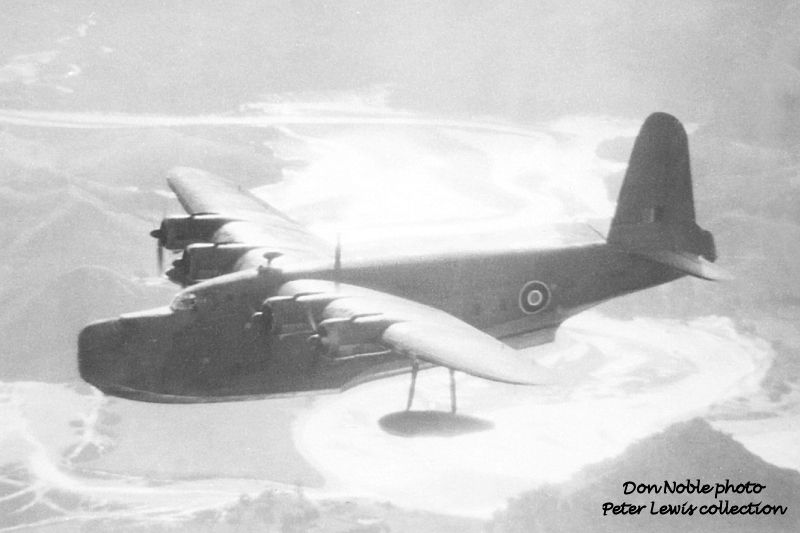 At Mechanics Bay, still wearing the RAF colours as ML792 At Mechanics Bay, still wearing the RAF colours as ML792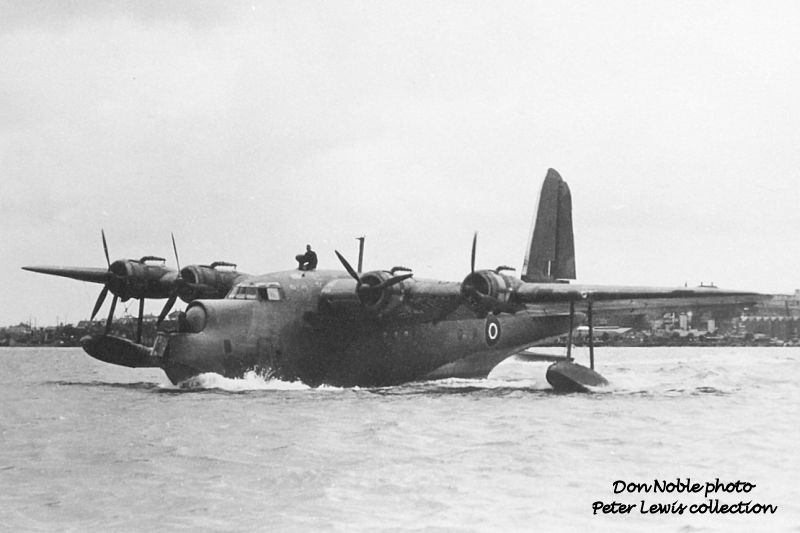  Upon arrival at Hobsonville, ML792 was bought on charge as NZ4101, had the ferry equipment removed and was fitted out for military freight and passenger transport operations. The Flying Boat Transport Flight was formed, with maintenance and traing facilities at Hobsonville and operational terminal at Mechanics Bay. The name 'Tainui' was applied to NZ4101, the name of one of the original Maori migration canoes from early New Zealand settlement. These were the first four-engined monoplane aircraft to be operated by the RNZAF. NZ4101 at Auckland in RNZAF markings prior to the name 'Tainui' being applied. Note the US-style bar markings have been added to the roundels to deter trigger-happy American gunners NZ4101 running number 2 engine on the hard at Lauthala Bay. The serial NZ4101 has been crudely applied over the blocked-out ML792 NZ4101 running number 2 engine on the hard at Lauthala Bay. The serial NZ4101 has been crudely applied over the blocked-out ML792 NZ4101 in Pacific Area markings, unknown Island locations. NZ4101 in Pacific Area markings, unknown Island locations. 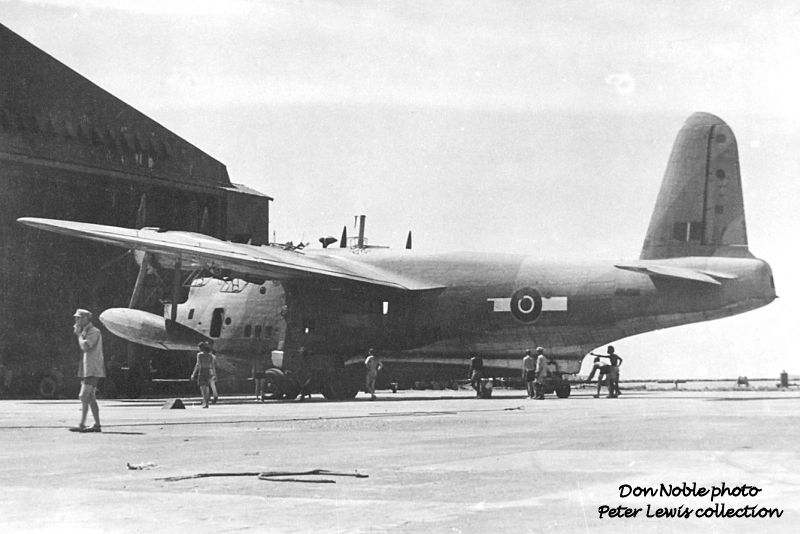 The Sunderlands of the Flying Boat Transport Flight were mainly used on Auckland-Fiji and Auckland -Noumea-Espiritu Santo routes from February 1945 until laid up at Hobsonville in October 1945 with engine/propellor problems. NZ4101 saw some use in early 1946 training TEAL crews for the about-to-arrive Sandringhams. By June that year, with camouflage removed but still carrying military markings, it was operating on the Auckland-Fiji run mostly carrying civilian fare-paying passengers. On the water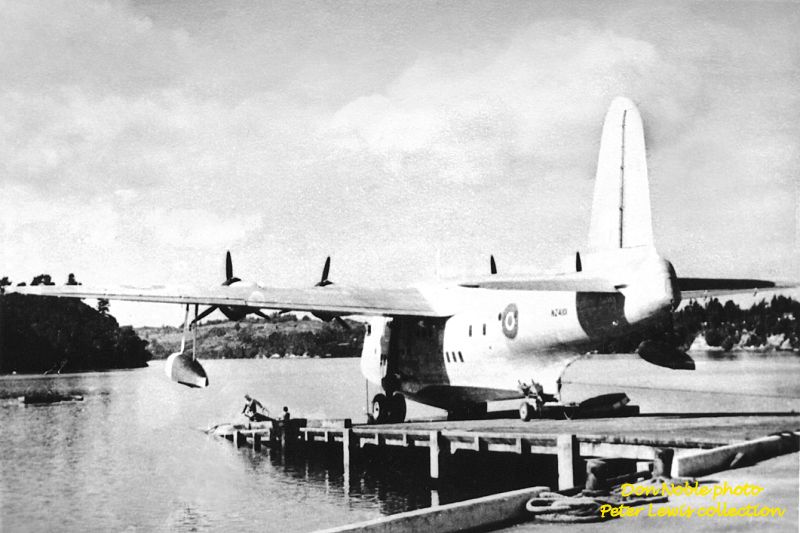 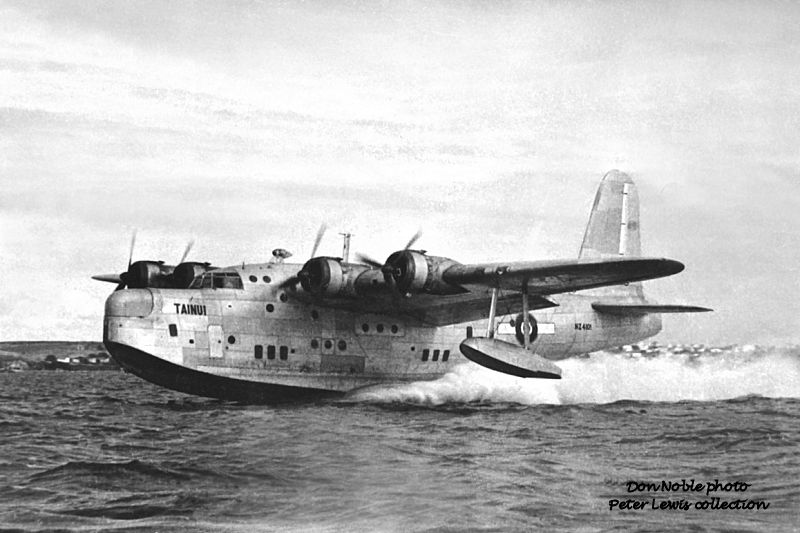 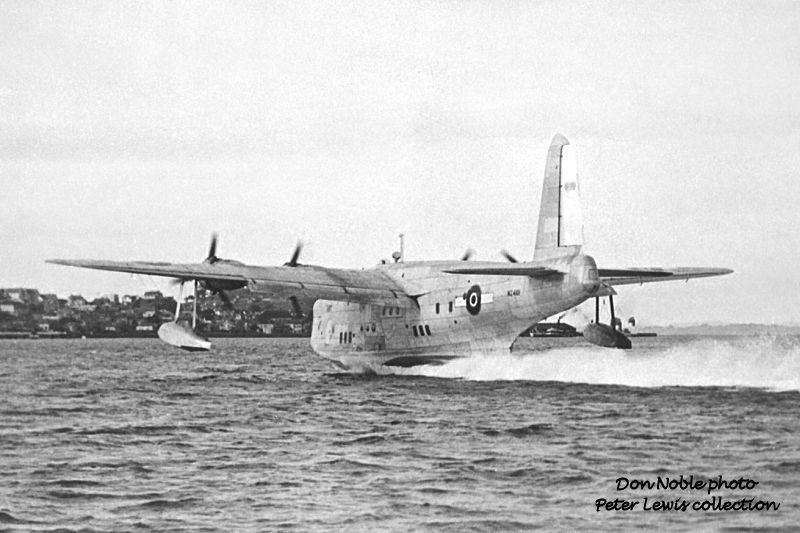 NZ4101 over the Auckland Harbour in July 1946 NZ4101 over the Auckland Harbour in July 1946 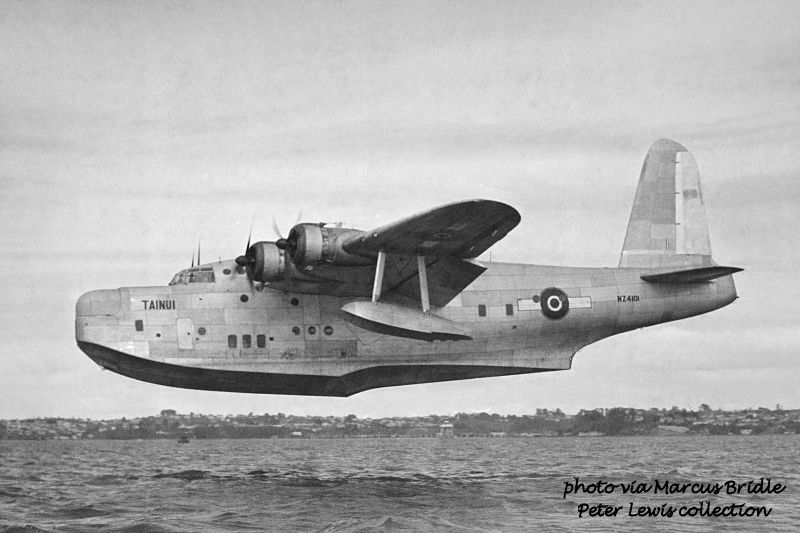 This service was legitimized in in 1947 when two of the Sunderlands adopted civil identities with the Government-owned National Airways Corporation, and NZ4101 was also transfered to NAC on 16Dec1947 as a spares source. The registration ZK-AMJ was reserved for use by NZ4101, but this was never adopted and ZK-AMJ was reallocated to another aircraft at a later time. NZ4101 stayed in reserve at Hobsonville until released back to the RNZAF in October 1949. In storage at Hobsonville The Air Force had no use for this aircraft, and it was sold by tender dated 10Oct1949 and was scrapped at Hobsonville in December 1949. The paperwork limped much further behind, with NZ4101 being officially taken back on charge from NAC on 14Sep1952 and struck off charge on 16Dec1957! The scrapping process was not a pretty sight. Hobsonville 29Dec1949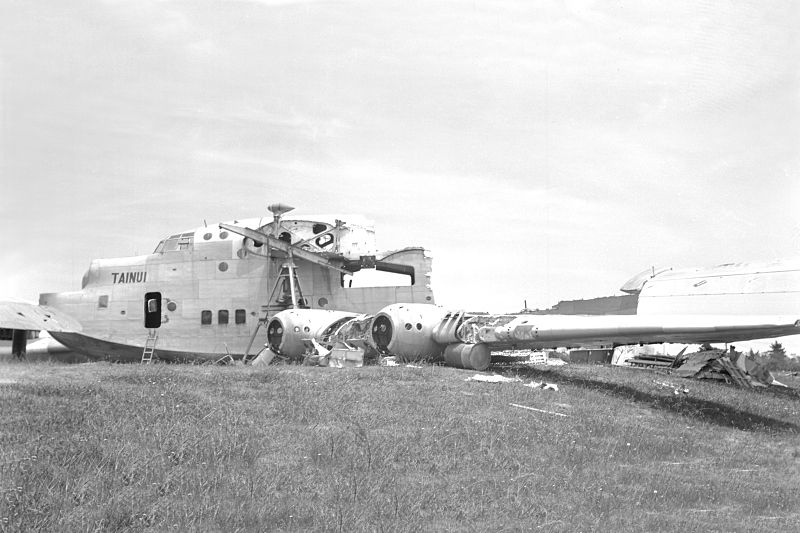  The Catalina on the left is NZ4039 The Catalina on the left is NZ4039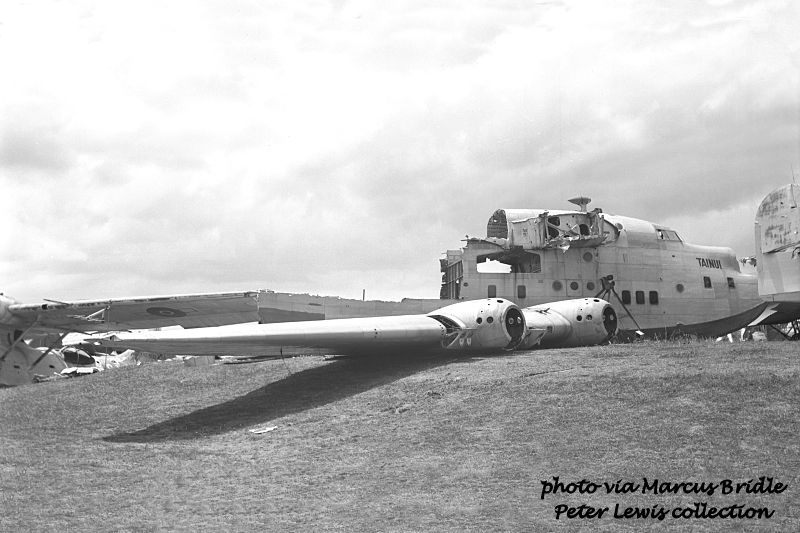 The wing of ex-TEAL PB2B-1 Catalina NZ4035/ZK-AMI makes an appearance in this photo The wing of ex-TEAL PB2B-1 Catalina NZ4035/ZK-AMI makes an appearance in this photo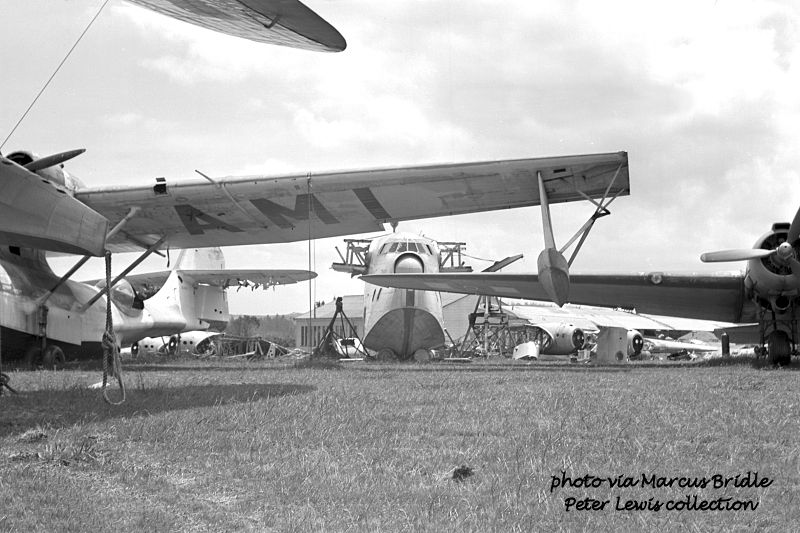 |
|
|
|
Post by Peter Lewis on Oct 28, 2012 7:58:44 GMT 12
NZ4102: Short S.25 Sunderland III ML793 had been built by Shorts at Rochester, shop order no.SB46656 and was bought on charge with the Air Council on 18Sep1944. This aircraft departed RAF Mount Batten on 28Oct1944 with Flt Lt Keith Patience as Captain to travel on the same delivery route as ML792 to Lauthala Bay in Fiji, met up there with its fellows, and finally flew to Auckland on 2Dec1944. This trip took ML793 116hrs 50mins flying hours. Upon arrival at Hobsonville, ML793 was bought on charge as NZ4102 4Dec1944, had the ferry equipment removed and was fitted out for military freight and passenger transport operations. As part of the Flying Boat Transport Flight, the name 'Tokomaru' was applied to NZ4102, the name of one of the original Maori migration canoes from early New Zealand settlement. ML793 in the process of becoming NZ4102 at Mechanics Bay December 1944. Note the ladder for scaling the fin! NZ4102 was employed on the Auckland - Suva and Auckland - Noumea - Espirutu Santo routes from February to October 1945. NZ4102 during servicing at Hobsonville prior to the war's end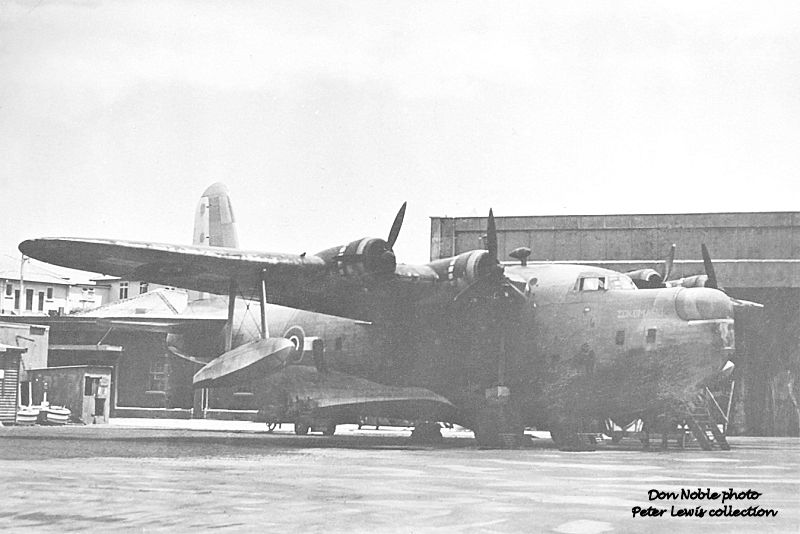 Takeoff on the Auckland harbour Takeoff on the Auckland harbour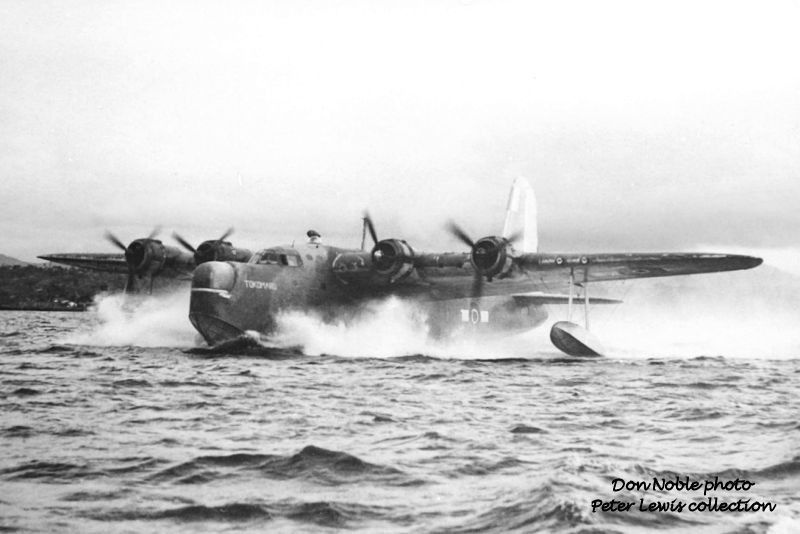 Photo taken at Mechanics Bay, said to be January 1946 but this must be an error as the aircraft still carries full camouflage colours Photo taken at Mechanics Bay, said to be January 1946 but this must be an error as the aircraft still carries full camouflage colours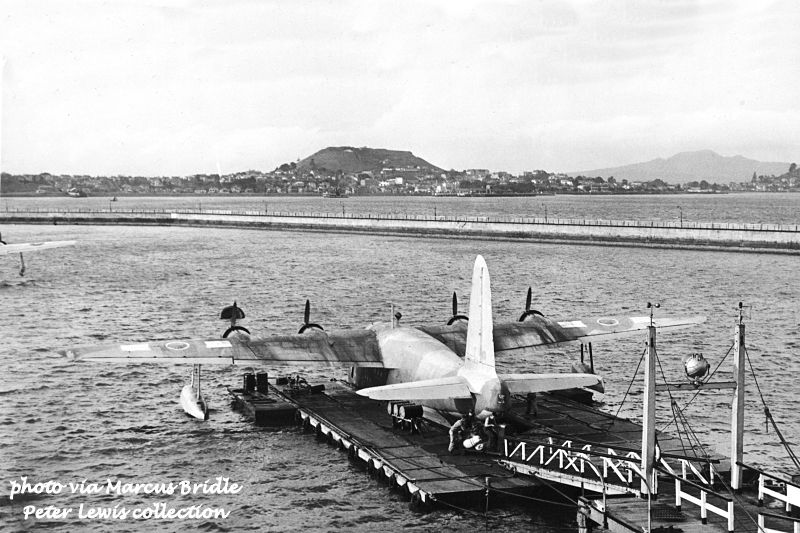 In postwar service, natural metal and RAF-type roundels 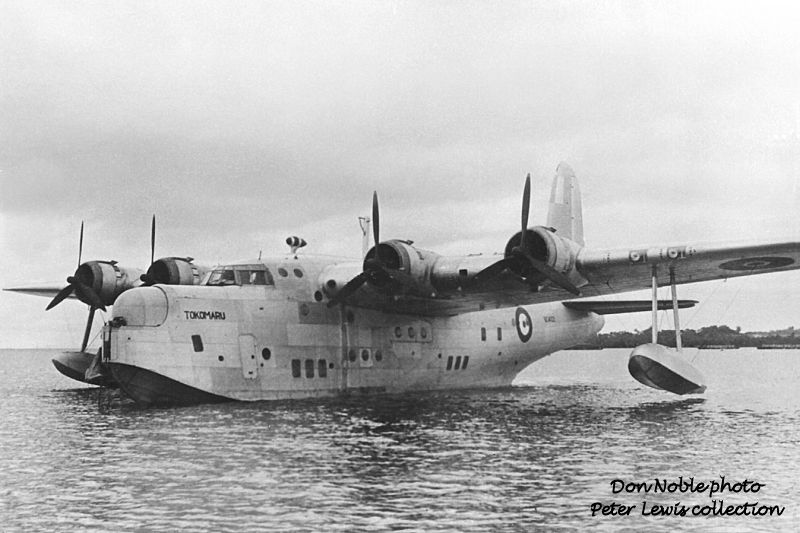 NZ4102 was then laid up at Hobsonville awaiting resolution of the engine/propeller problems that had surfaced during Pacific Service. NZ4102 stored on the hard at Hobsonville late 1945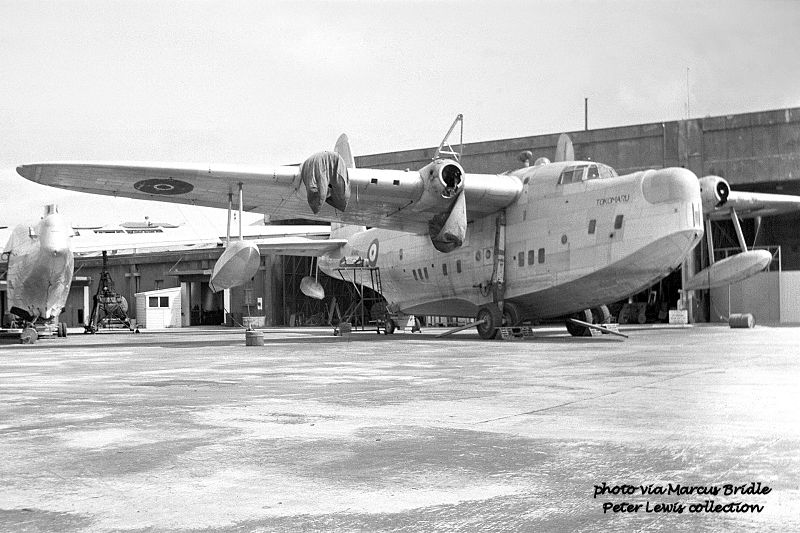 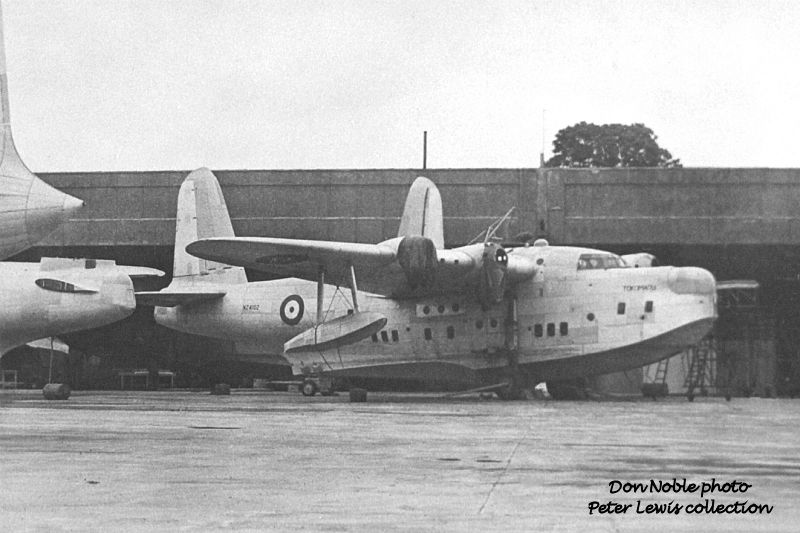 Cockpit view of one of the RNZAF MkIII Sunderlands 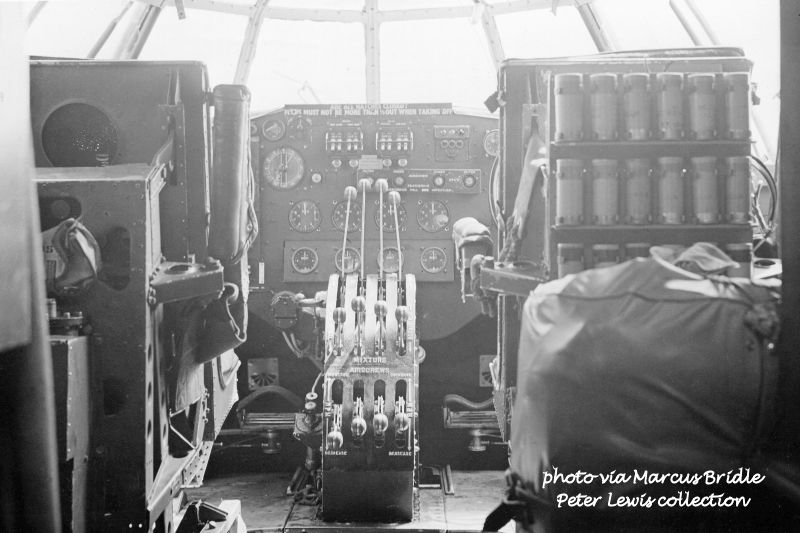 Along with NZ4101, NZ4102 was reactivated to carry out training flights for TEAL aircrew in readiness for the arrival of the Sandringham boats later that year. By June 1946, it was in use for the RNZAF joint civil/military service on the Auckland - Fiji route, making its first trip on 6Jun1946. In order to regualrise this service, NZ4102 was transferred, along with NZ4103, to the Government-owned New Zealand National Airways Corporation on 16May1947. NZ4103 had already been converted to full civilian passenger layout, and worked commenced on NZ4102 at Hobsonville for its proposed passenger role as ZK-AMF. At this point things become a little fuzzy. NZ4102 was transferred back to the RNZAF and the registration ZK-AMF cancelled on 22Dec1947. Work then proceeded on converting NZ4104 to civilian layout as ZK-AMK. I do not believe NZ4102 ever entered service as ZK-AMF, and photographs of this aircraft in later years show it still painted up in military marks as NZ4102. I have never seen a photo of it as ZK-AMF. Other flying boats that were returned to the RNZAF after civilian use were not repainted back into military colours. I assume that some problems were found with NZ4102 early in the conversion process, and it was easier to convert NZ4104 than to fix these problems on NZ4102. In any event, NZ4102 stayed at Hobsonville in reserve, and was later moved up into 'rotten row' on the grass airfield parked among the retired Catalinas. In July or early August 1949, there was a major storm in Auckland, and several of the stored aircraft were blown off their pickets and smashed into each other. As can be seen from these photos taken on 2Aug1949, NZ4102 suffered damage to the rudder, fin, elevators, tail cone and port wing The RNZAF Catalina just beyond NZ4102 is NZ4017 XX-T, while the one behind is NZ4052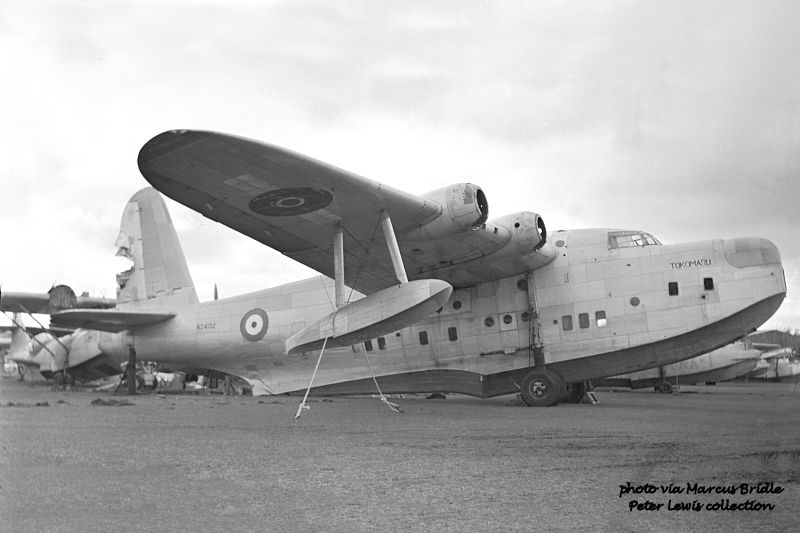 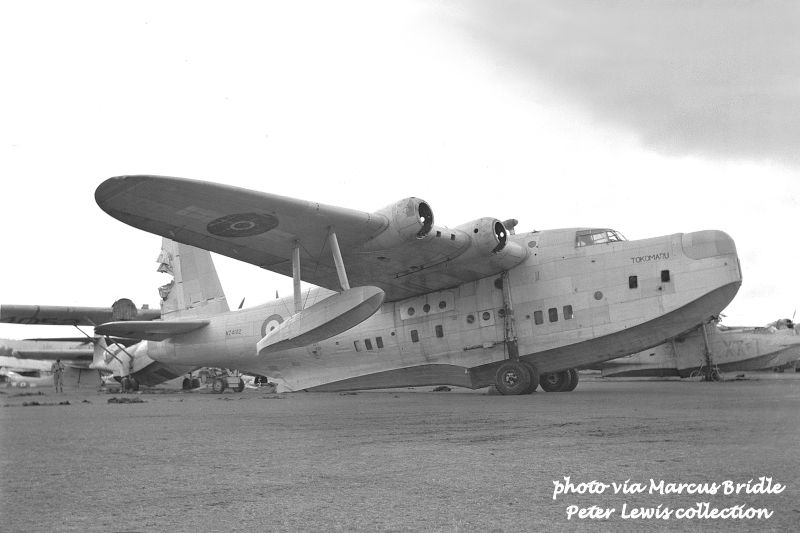 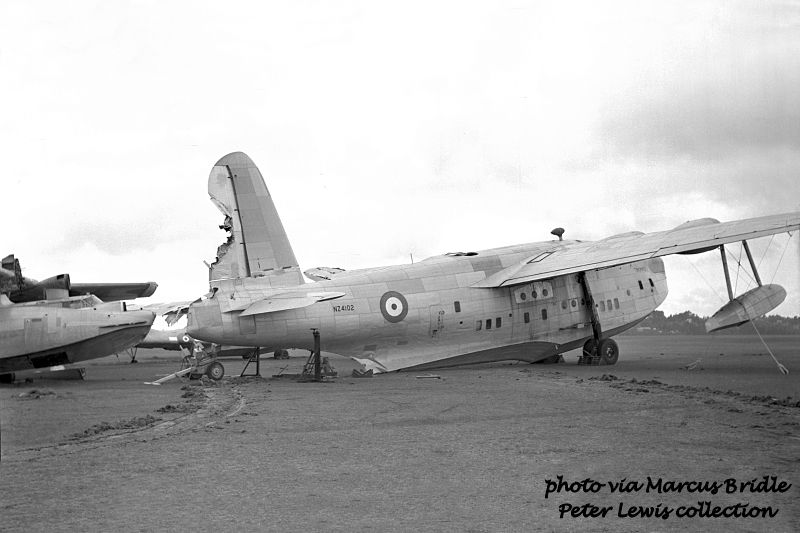 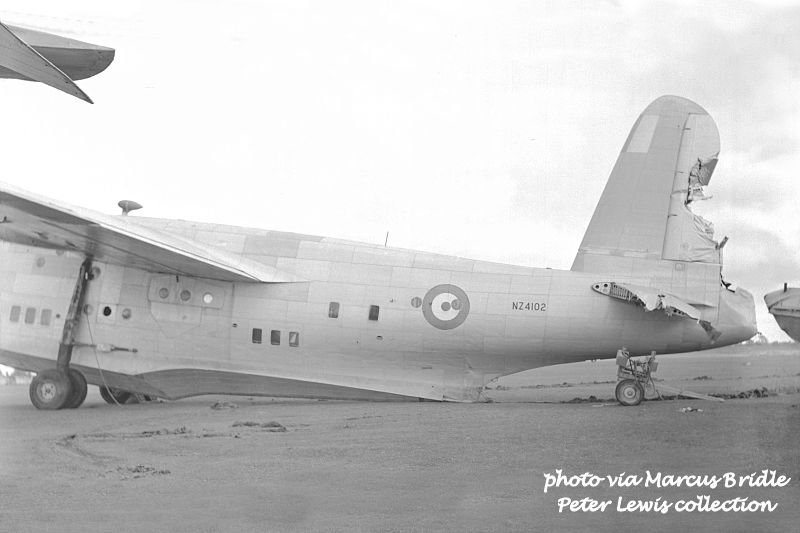 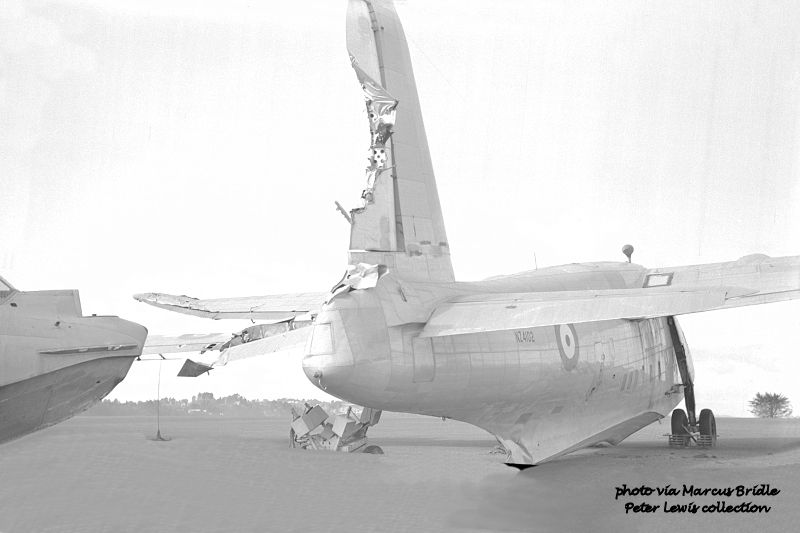 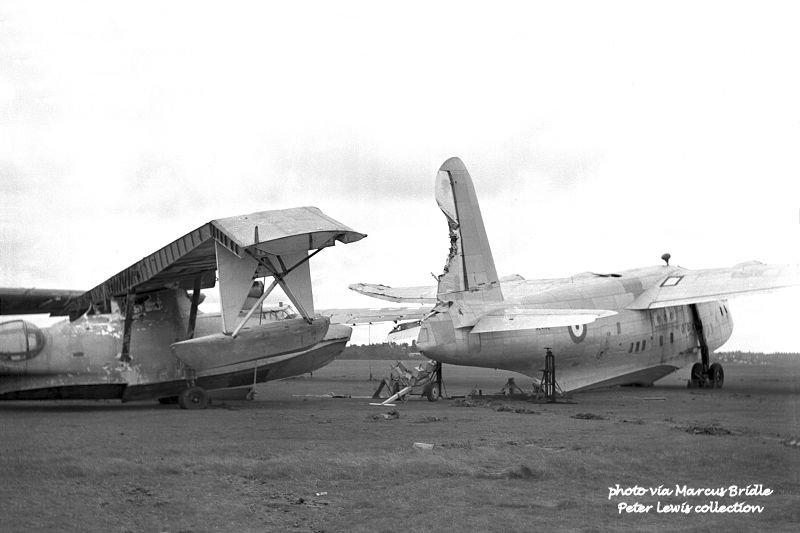 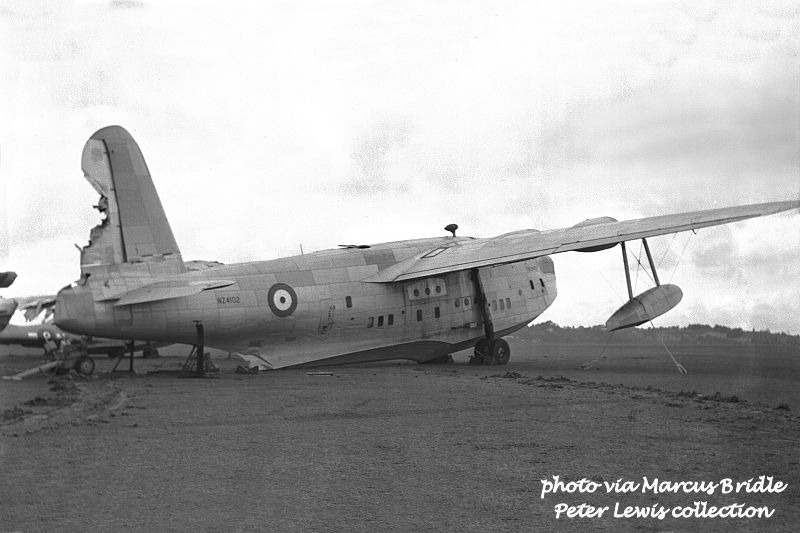 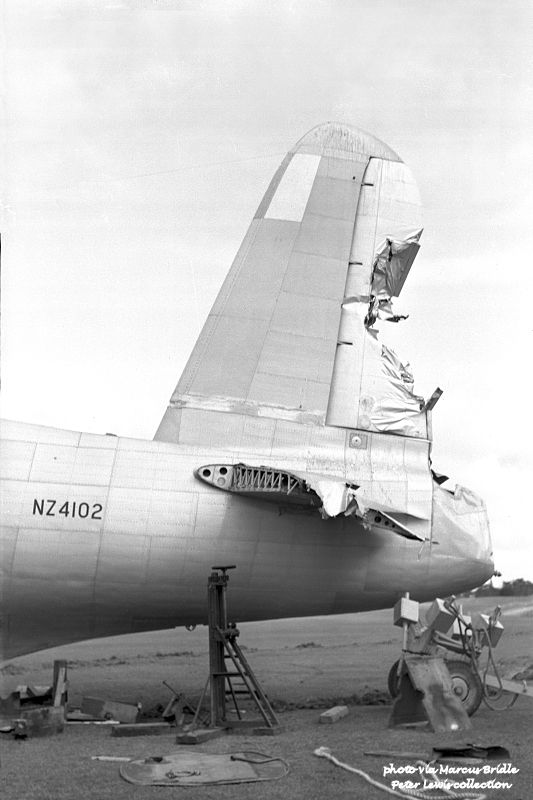 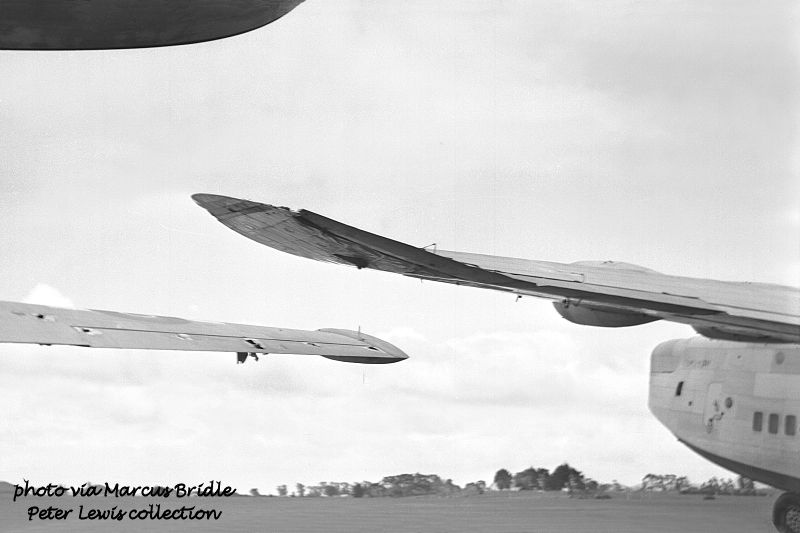  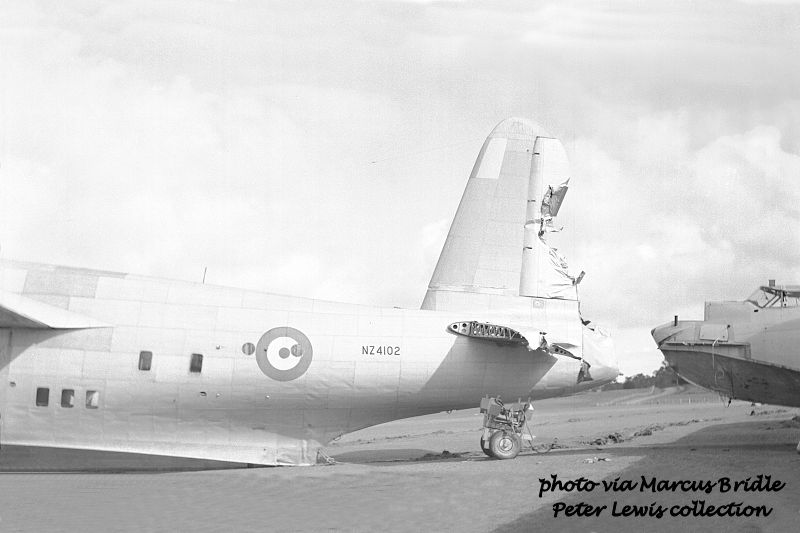 By the 29Dec1949, when this photo was taken, the aircraft had been re-fastened to its tiedowns, but the damage is still evident. It lingered in this state for several years. 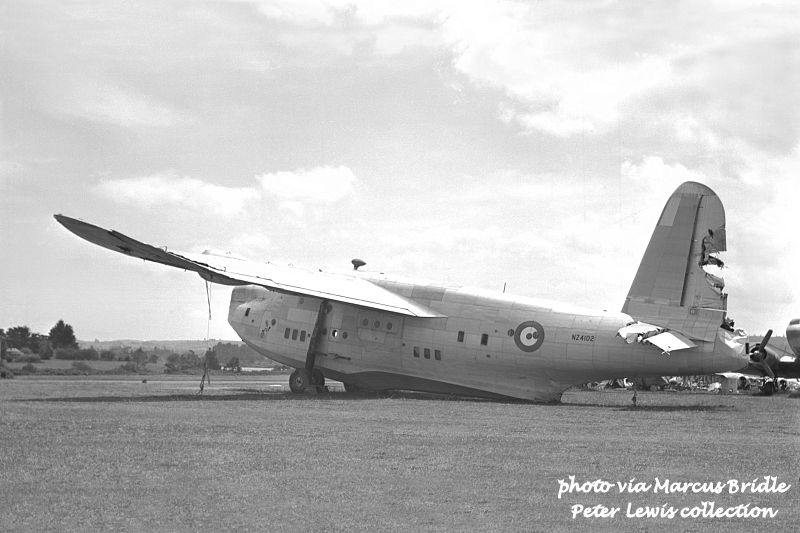 NZ4102 resting at Hobsonville, alongside various Catalinas and a C-47 NZ4102 resting at Hobsonville, alongside various Catalinas and a C-47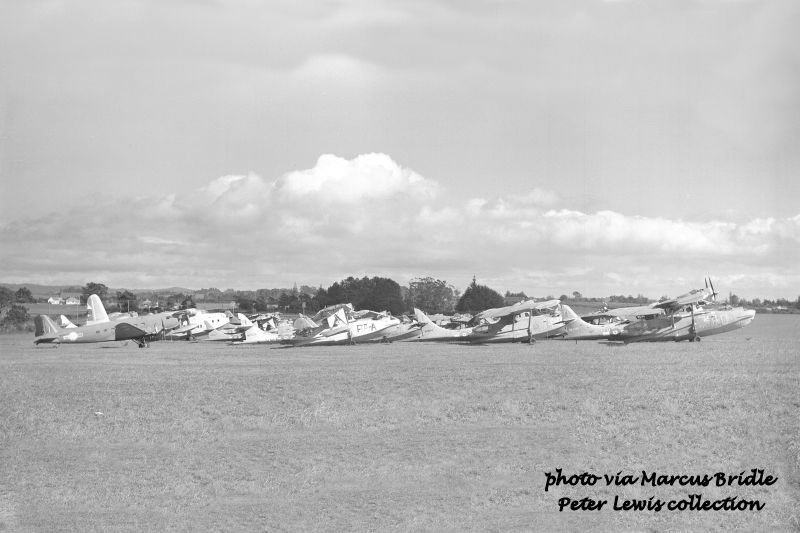 Eventually, NZ4102 was sold to the scrap merchant and cut up on site during 1955. |
|
|
|
Post by Peter Lewis on Oct 28, 2012 7:59:55 GMT 12
NZ4103: Short S.25 Sunderland III ML794 had been built by Shorts at Rochester, shop order no.SB46667 and was bought on charge with the Air Council on 12Sep1944. This aircraft departed RAF Mount Batten on 21Oct1944 with Flt Lt Joe Shephard as Captain to travel alongside ML792 to Lauthala Bay in Fiji, but suffered an engine failure after leaving San Francisco and thus arrived at Hawaii on three engines. After delivery and fitting of a replacement engine, it was the last of the four Sunderlands to arrive at Lauthala Bay in Fiji where it met up with its fellows. ML794 finally flew to Auckland on 2Dec1944 where it suffered a midair collision with RNZAF Lodestar NZ3514 which had been despatched from Whenuapai with a cameraman on board to film the four Sunderlands arrival. ML794 was forced into a sea landing and the indignity of a tow by a handy fishing boat to Whangarei Heads, where repairs were carried out and the aircraft finally arrived at Hobsonville on 5Dec1944. This trip took ML794 124hrs 45mins flying hours. ML794 overhead Northland 2Dec1944, moments before the mid-air incident ML794 after arrival at Hobsonville. Presumably the weight-testers are the delivery crews of the four Sunderland aircraft ML794 after arrival at Hobsonville. Presumably the weight-testers are the delivery crews of the four Sunderland aircraft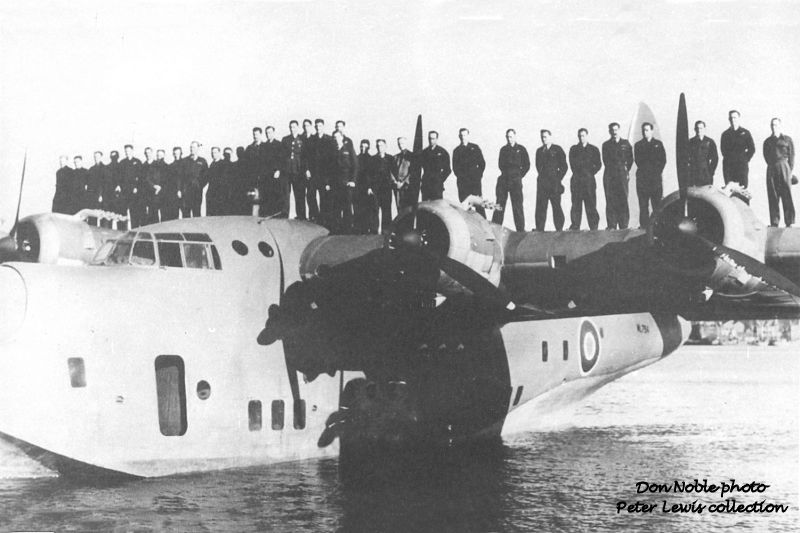 Upon arrival at Hobsonville, ML794 was bought on charge as NZ4103 4Dec1944, had the ferry equipment removed and was fitted out for military freight and passenger transport operations. As part of the Flying Boat Transport Flight, the name 'Mataatua' was applied to NZ4103, the name of one of the original Maori migration canoes from early New Zealand settlement. NZ4103 was employed on the Auckland - Suva and Auckland - Noumea - Espirutu Santo routes from February to October 1945, losing its wartime camouflage in favour of a natural metal finish after VJ day. Moored out at Auckland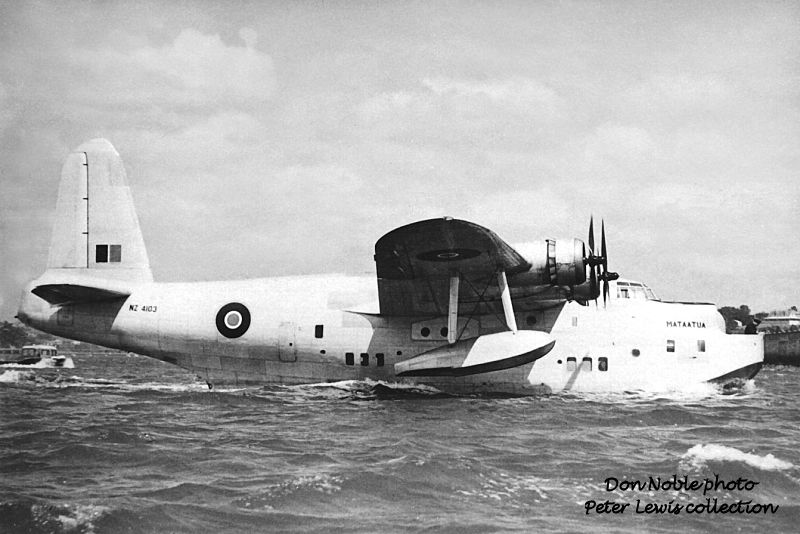 NZ4103 on the step, Auckland harbour NZ4103 on the step, Auckland harbour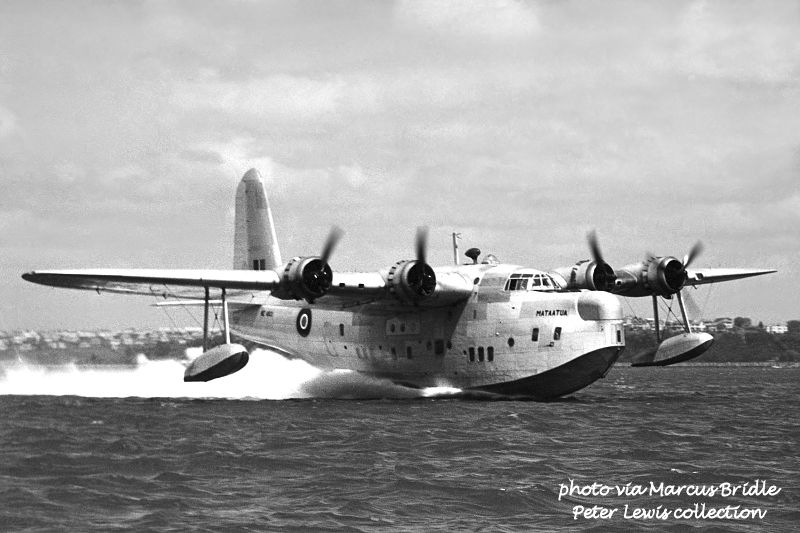  NZ4103 was then laid up at Hobsonville in October 1945 awaiting resolution of the engine/propeller problems that had surfaced during Pacific Service. At Hobsonville late 1945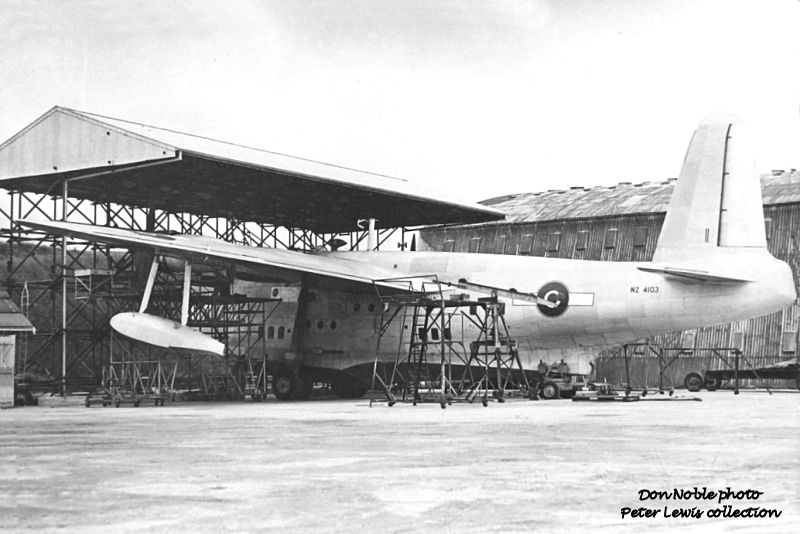 By January 1946, civilian use for the Sunderland fleet had been identified, and conversion of NZ4103 to a 26 passenger civilian standard had started at Hobsonville. This work must have proceeded slowly, as it did not participate in the Auckland - Fiji service that operated in mid-1946 NZ4103 undertook its post-conversion test flight over Auckland on 26 Oct1946 and few days later flew to Evans Bay to operate a proving flight from Wellington to the Chatham Islands. The pilots conducting the test flights on 26 October 1946 of 1 hour 30 min and 3 hours 45 min were Flt Lt Layne and Sqdn Ldr Mackgill. Following this test, NZ4103 then re-entered service with the Flying Boat Transport Flight on their quasi-civil transport operations. NZ4103 at the Mechanics Bay terminal 1947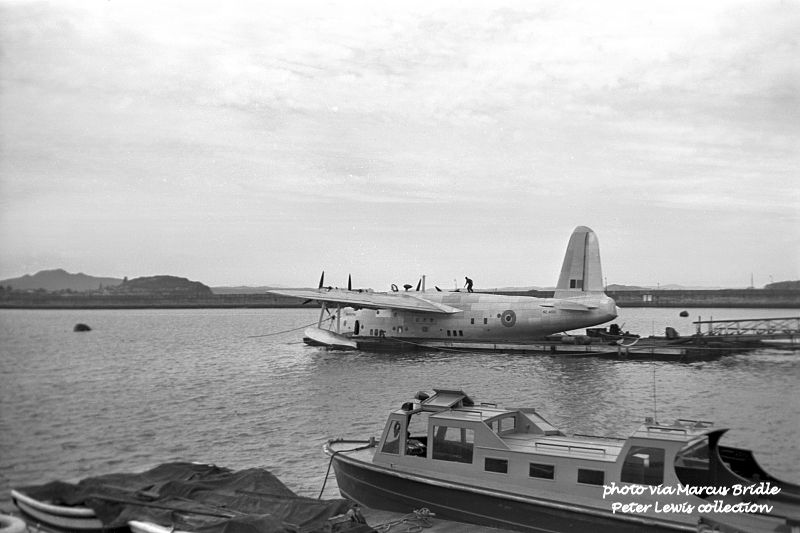  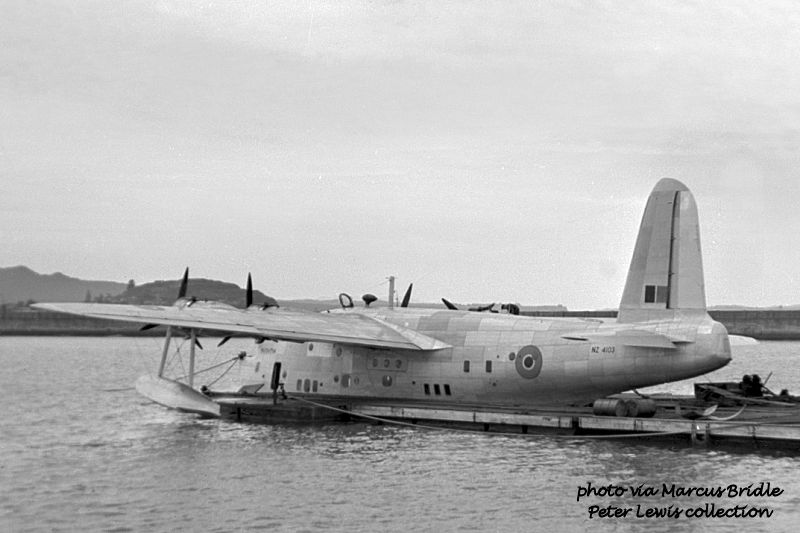 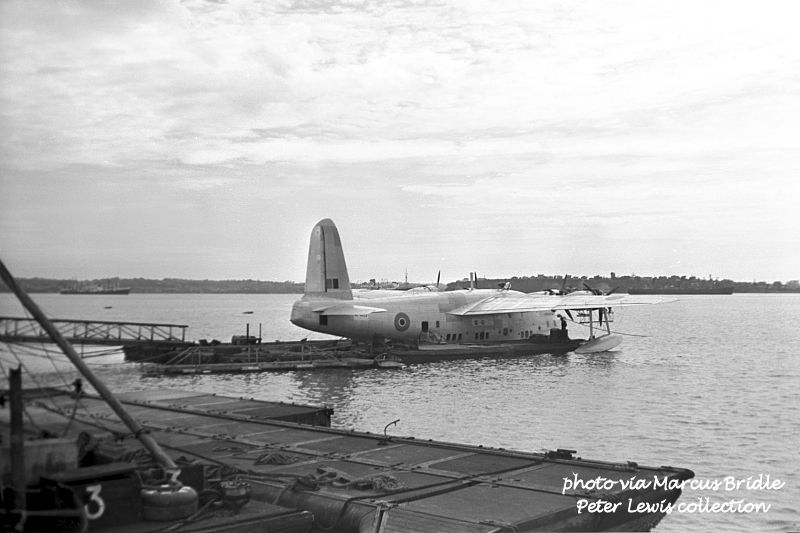 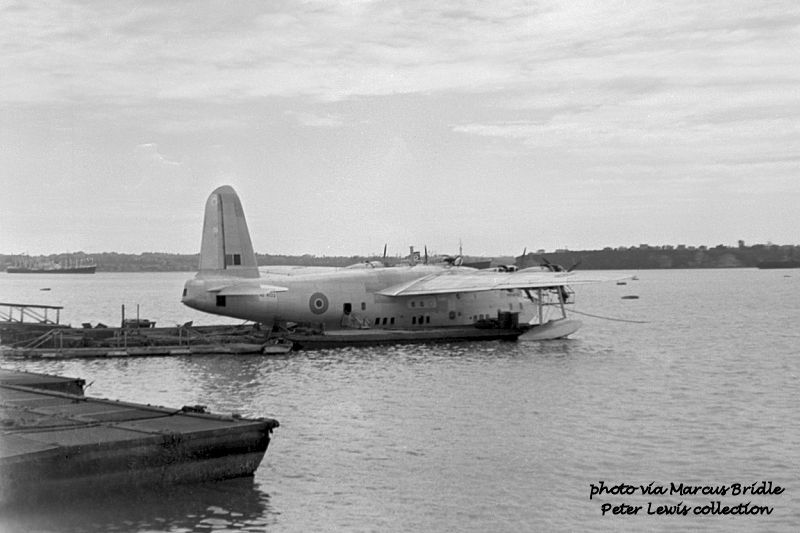  On 30Sep1947, NZ4103 was transferred to the National Airways corporation, along with NZ4102, and became ZK-AMG. Already converted to full civilian standard, it was able to enter NZNAC service immediately on the Auckland - Suva - Labasa route and continued reliably in service until 30Mar1949. ZK-AMG under maintenance at Hobsonville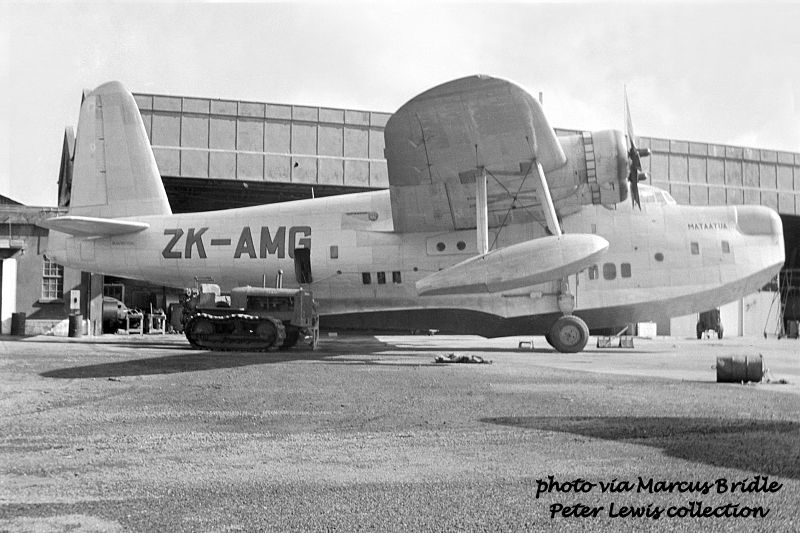 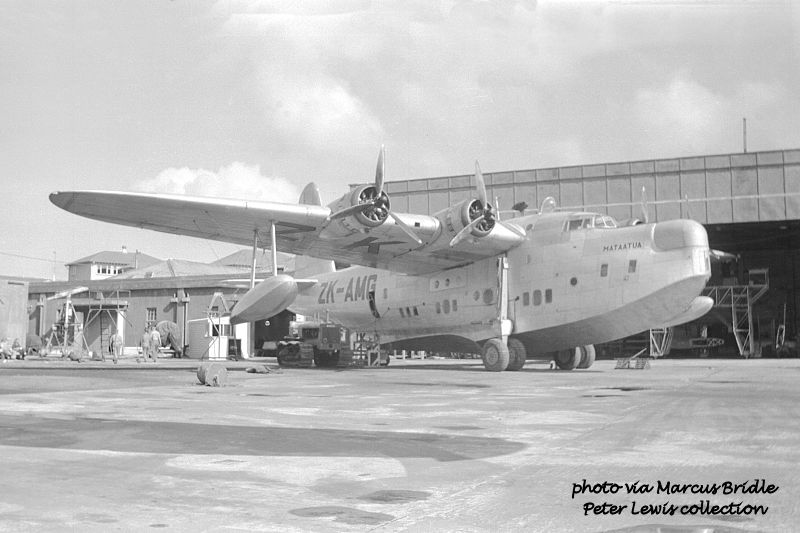 Moored out at Hobsonville Moored out at Hobsonville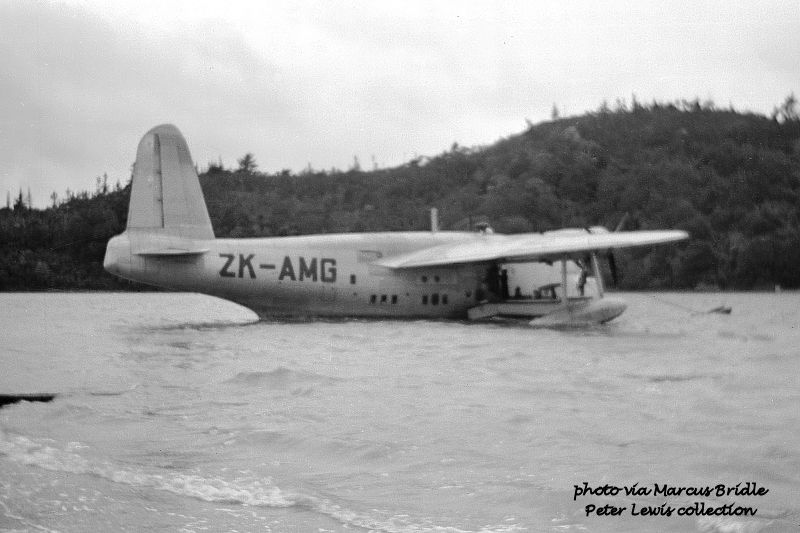 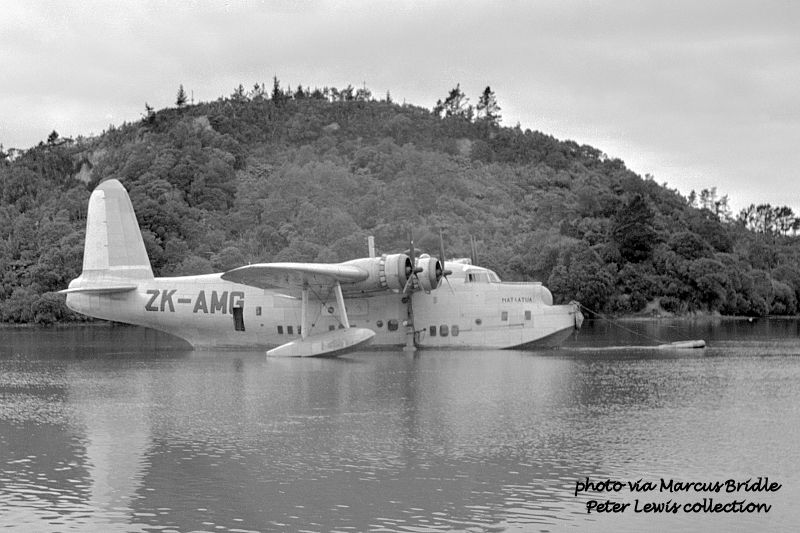 At the conclusion of NZNAC service in March 1949. ZK-AMG was returned to the RNZAF and taken back on charge as NZ4103 on 9Feb1951 - most likely a book entry in preparation for an offer of sale by tender in May 1951. In any event the aircraft remained in outside storage at Hobsonville and was re-offered for sale in late 1953 and broken up for scrap in 1954. ZK-AMG stored at Hobsonville after the RNZAF resumed ownership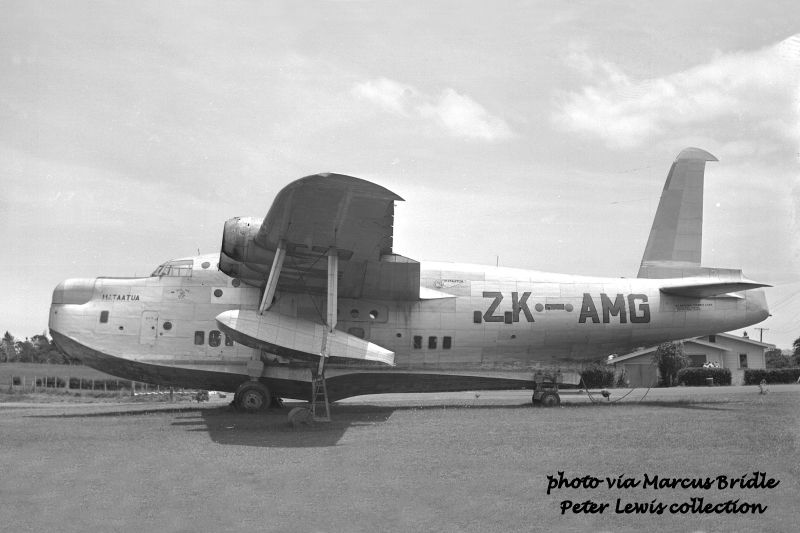 |
|
|
|
Post by Peter Lewis on Oct 28, 2012 8:00:57 GMT 12
Short S.25 Sunderland III ML795 had been built by Shorts at Rochester, shop order no.SB46668 and was bought on charge with the Air Council on 23Sep1944. This aircraft departed RAF Mount Batten on 28Oct1944 with Flt Lt Jack Pettit as Captain to travel alongside ML793 to Lauthala Bay in Fiji. ML795 flew to Auckland on 2Dec1944. This trip took ML795 124hrs 45mins flying hours. Upon arrival at Hobsonville, ML795 was bought on charge as NZ4104 on 4Dec1944, had the ferry equipment removed and was fitted out for military freight and passenger transport operations. As part of the Flying Boat Transport Flight, the name 'Takitimu' was applied to NZ4104, the name of one of the original Maori migration canoes from early New Zealand settlement. NZ4104 was employed on the Auckland - Suva and Auckland - Noumea - Espirutu Santo routes from February to October 1945, losing its wartime camouflage in favour of a natural metal finish after VJ day. NZ4104 at Mechanics Bay while in service with the FBTF, another Sunderland gets engine maintenance in the foreground NZ4104 was then laid up at Hobsonville in October 1945 awaiting resolution of the engine/propeller problems that had surfaced during Pacific Service. In storage at Hobsonville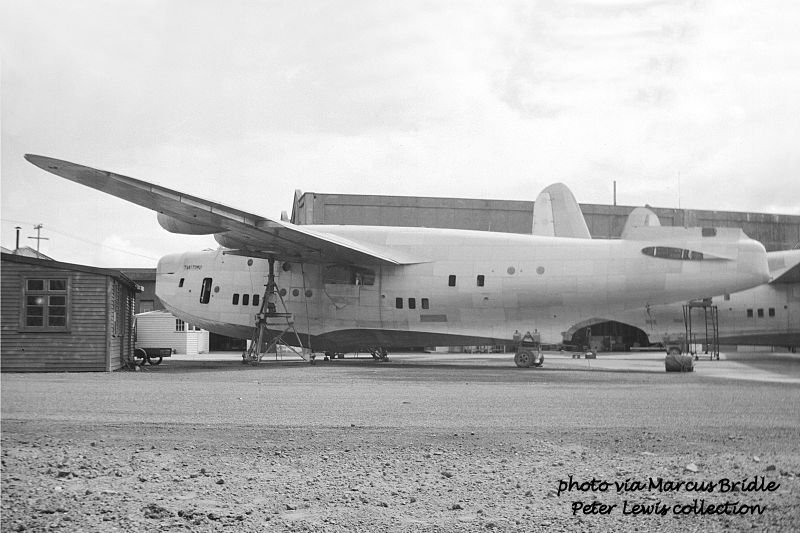 By January 1946, civilian use for the Sunderland fleet had been identified, and conversion of NZ4103/ZK-AMG to a 26 passenger civilian standard had started at Hobsonville, with work om NZ4102/ZK-AMF to follow. As already discussed, the conversion work on NZ4102 apparently ran into difficulties and NZ4104 was selected to replace it. Ownership of NZ4104 was therefore transferred to the NZ National Airways Corporation and the aircraft became ZK-AMK on 22Dec1947 equiped to carry 26 passengers. ZK-AMK was operated alongside ZK-AMG on the Auckland - Suva - Labasa route, making its last commercial flight on 1Jun50. ZK-AMK moored out at Mechanics Bay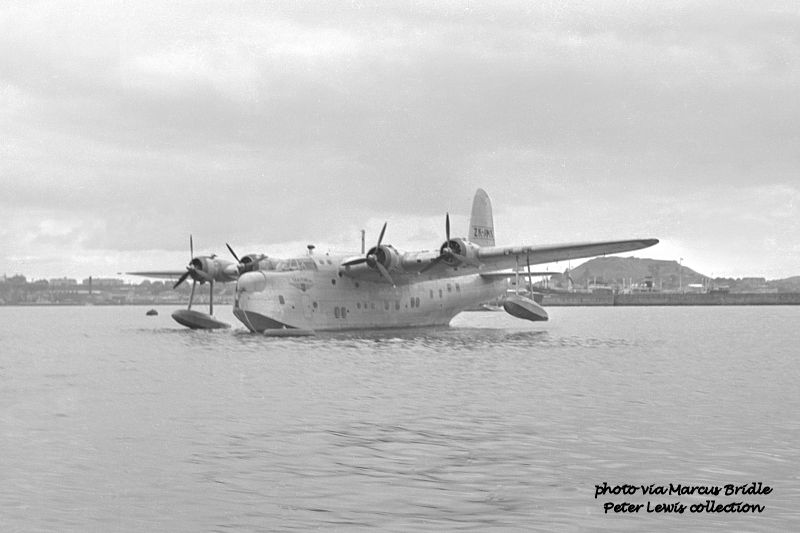 Under maintenance at Hobsonville Under maintenance at Hobsonville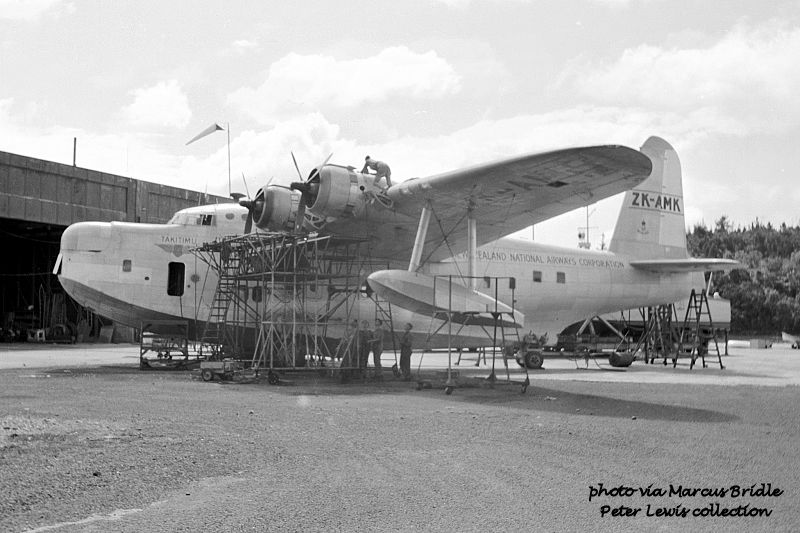 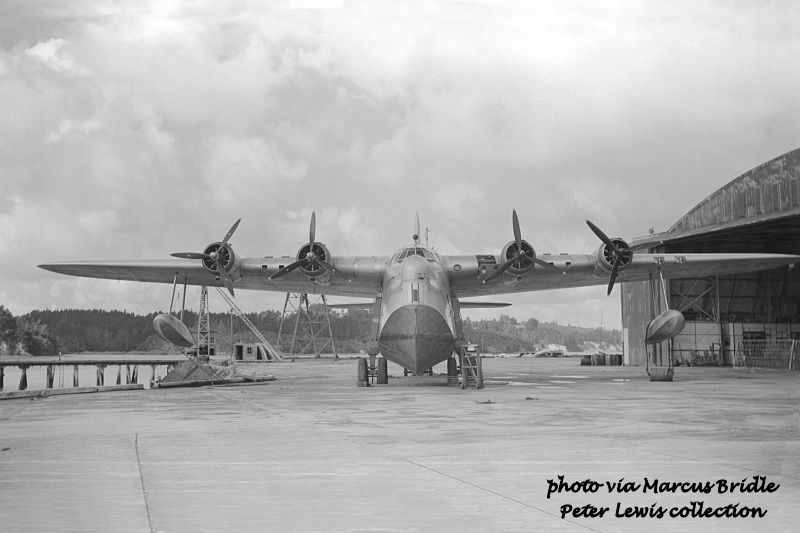 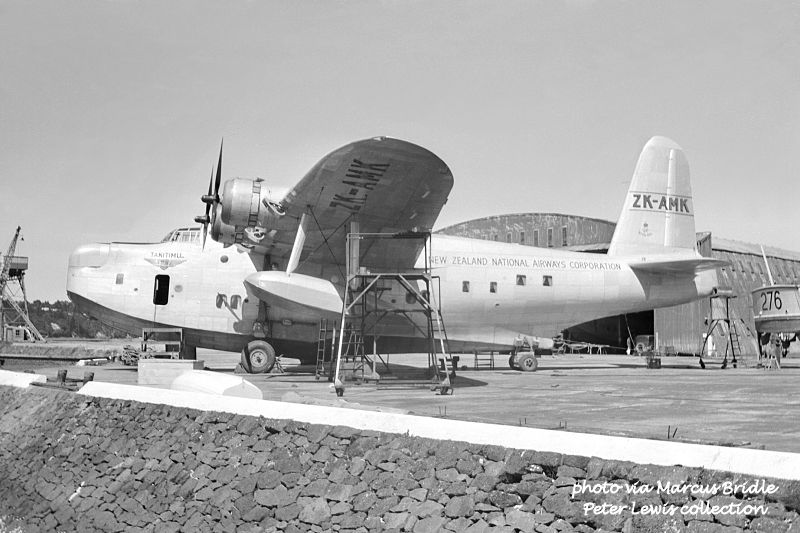 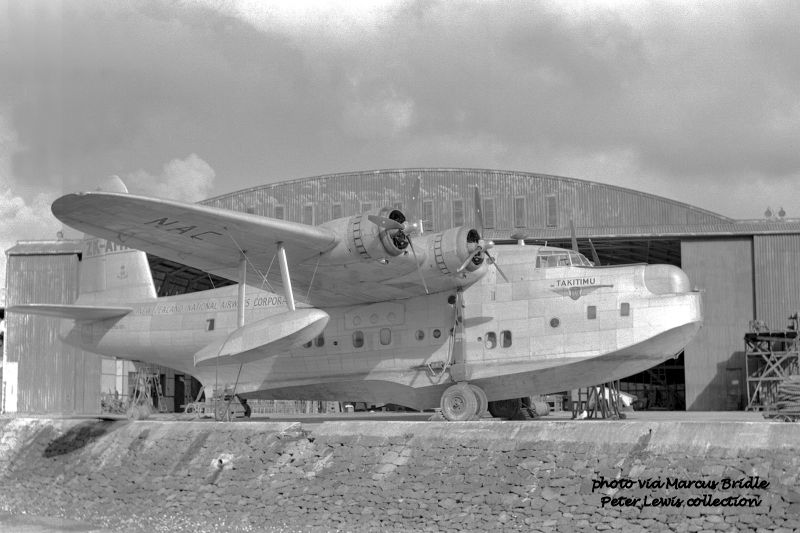 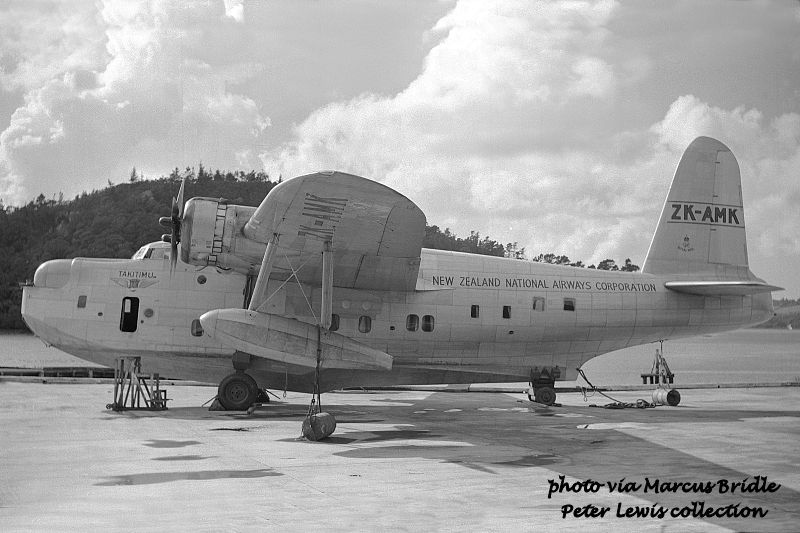  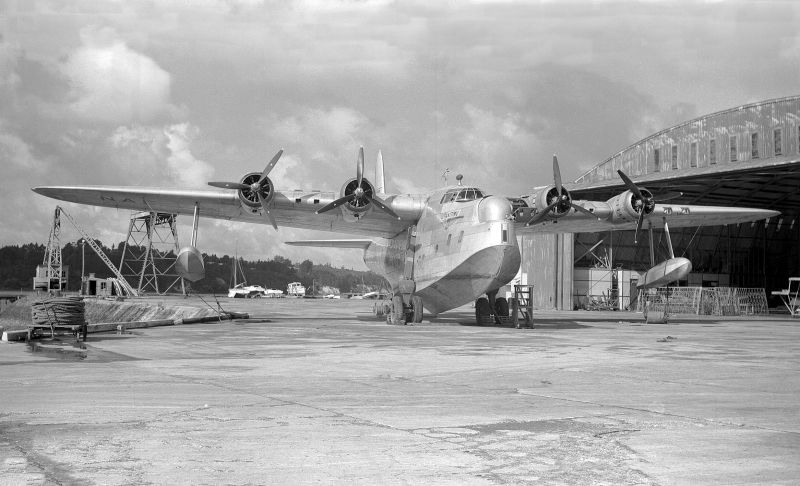  Moored out at Hobsonville Moored out at Hobsonville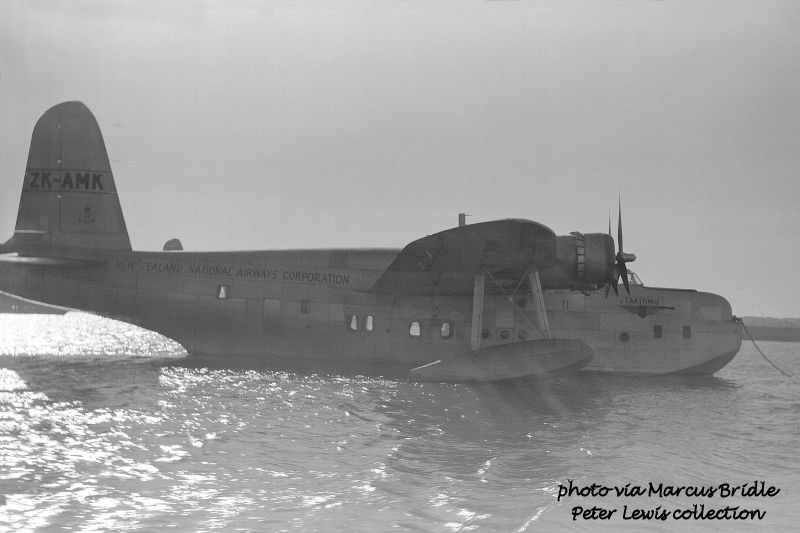 After its service with NZNAC, ZK-AMK was returned to the RNZAF, where is was placed in storage at Hobsonville. It was bought back on charge as NZ4104 so that it could be offered for sale by tender on 28May1951, but it was not sold at that time. By now, the purchase of the ex-RAF Sunderland Mk.5 fleet was imminent so NZ4104 was repainted back into military colours and used by 6 Squadron to train crews in the water handling and beaching procedures of these aircraft. Deemed seaworthy but not airworthy, NZ4104 carried out these duties from May 1952 until mid-1953. The civil registration ZK-AMK was not cancelled until 8Jul1952. NZ4104 at Hobsonville 1953 in its last livery, simplified by just overpainting the civilian registration 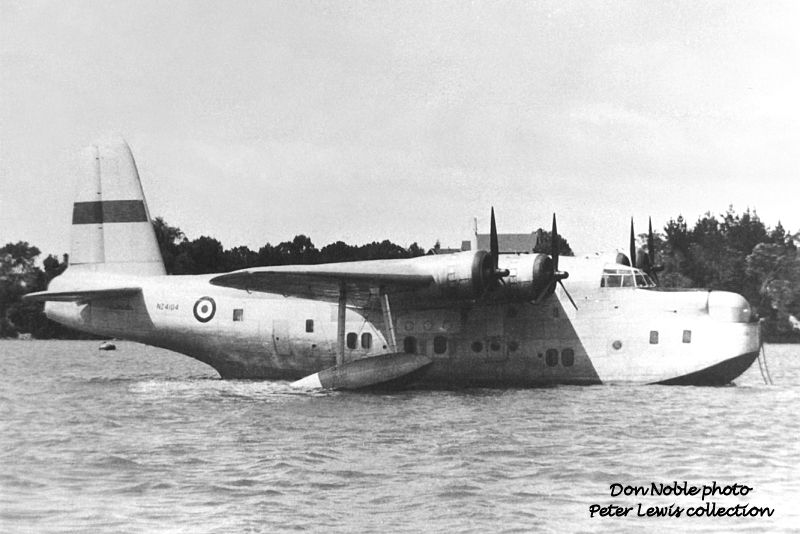 Feathered friend inspecting the starboard wingtip Feathered friend inspecting the starboard wingtip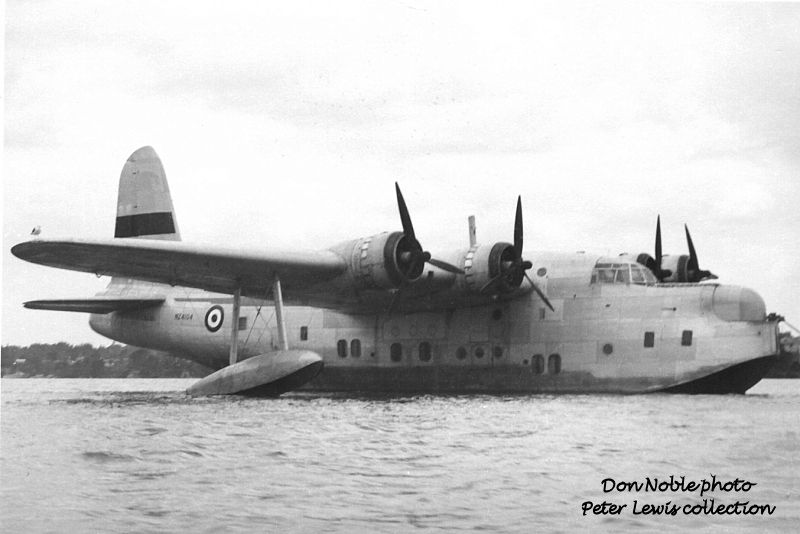 Following this episode, NZ4104 was again offered for sale by tender on 23Nov1953. This time, a sale was concluded and the scrapman cometh. However, the ghost of ZK-AMK lives on. When you are passing through the Wellington Airport domestic terminal, walk through to the departure shopping area, turn right walk along the rear wall until you come to the escalators that take you up to the third floor conference and Qantas domestic lounge complex. In the foyer of this third floor area is a glass case containing a nice model of Short Sunderland III ZK-AMK. On the wall above this model is a framed tribute to Brian Layne, one of the Sunderland transport pilots. Well worth a look and not many people know that it is there. 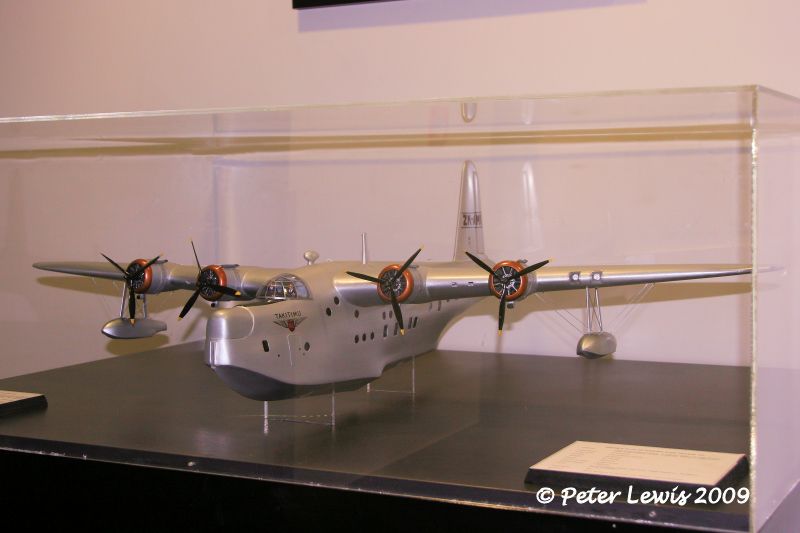 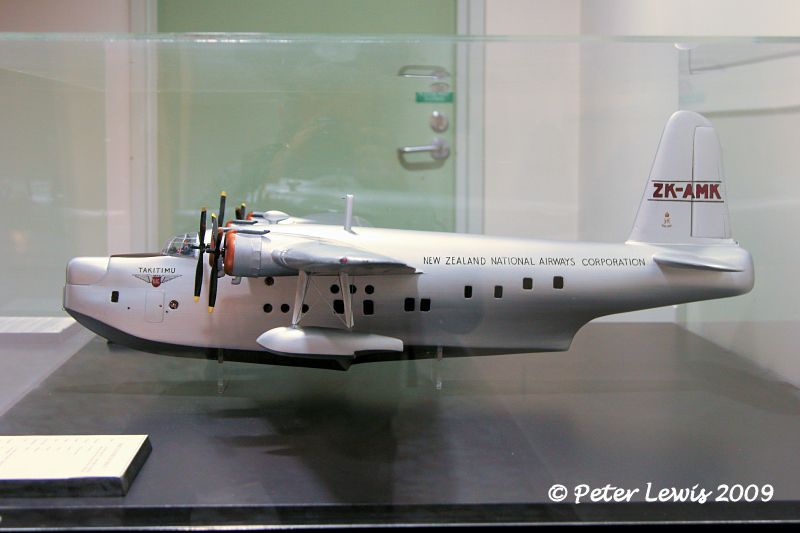 |
|
|
|
Post by Dave Homewood on Oct 28, 2012 9:23:16 GMT 12
All good information there but it does not answer my question about how the interior was configured for transport duties.
The comment that NZ4101 was the first four engined monoplane aircraft operated by the RNZAf isn't right, No. 1 Squadron operated the Short Empires on special patrols on many occasions. They had RNZAF crews aboard and flight planning, etc, was all through the RNZAF, even if on some of those flights they had passengers aboard for regular transport across the Tasman. They also operated the Empires taking VIP's to places like Fiji, Tonga and Hawaii through the war.
|
|
|
|
Post by Gary. on Oct 28, 2012 11:08:16 GMT 12
Nice one flyernzl.... ;D Great bit of history, and i love the old photos......Such a shame that none were saved in flying condition in New Zealand. I would say today tourists would be happy to pay top dollar for a spin around the Auckland water front in a Sunderland..........  |
|
|
|
Post by alanw on Oct 28, 2012 11:31:18 GMT 12
All good information there but it does not answer my question about how the interior was configured for transport duties. Hi Dave From what I can tell from my research on Sunderlands, the 4 Mk III's received by the RNZAF possibly may have been "Early Production" Sunderlands (though I have no interior photographic proof). Early production Mk III's had the generic wardroom bunks which would have been easy to configure for seating such as this MK V at Hendon. www.seawings.co.uk/images/Sunderland/RAF%20Mus%20WR/115.JPGThe early Production Mk III's also had bunkage on the rear decking in between the crew wardroom and the rear main hatch (these extra bunks were deleted on later production Mk III's). If we take into account in say the forward ward room 8-10 seats, crew ward room 8-10, and the extra bunkage 8-10, that make up 24-30 passengers. I recall reading some where a comment (it may have been Peter (flyernzl)) stating one of the RNZAF Mk III's carrying 30 RNZAF personel home to New Zealand. The other thing about the RNZAF Mk III's is that the normal way for bomb bay doors to open, is to slide down on rails on the inner fusaelage walls. In the excellent book "The Golden Age Of New Zealand Flying Boats", there is on pg 174, a great shot of the bomb bay door (portside) which has hinged in an up ward position. Now its also very possible that the bomb bay may have had seating too, if so that would account for seating of say 4 per bunk/seats, so still close to 30 odd passengers. With respect to cargo, mail and small amounts of cargo would have been carried in the bow section and in the area to the rear of the rear main hatch. Note some of the extras like bomb racks would have been removed, plus any additional equipment required by a normal Mk III's Sunderland (turret rings racking for flares etc) also, so weight savings there. What I find interesting, is (so far as I have seen) any other Mk III's used for trasportation remained with the usual portholes etc as in this photo link. i40.photobucket.com/albums/e242/hkins/Alans%20Planes/760_468_csupload_43308765copy_zps0d79888a.jpg(Photo used for illustration only) These Sunderlands were fitted with simple "Austerity Benches", it's possible that the RNZAF Mk III's could have had those too, but my thinking is that the crew would still need banks to sleep on, so may have retained bunks. Hope that helps? Regards Alan |
|
|
|
Post by davidd on Oct 29, 2012 9:01:59 GMT 12
Aircraft in foreground in first photo in reply #7 is actually a TEAL S.30 Empire boat - note the cylinder heads on the visible engine, this is one of the sleeve valve Bristol Perseus engines (by now fitted with the DH/Hamilton Standard Hydromatic full-feathering props).
Incidentally this is by far the best group of photos of the NZ Sunderland IIIs I have ever seen, by far, most excellent stuff! Incidentally the first RNZAF Sunderland to be "scraped down" to a bare metal finish was NZ4101, which was completely stripped during a major inspection and modification programme between 16/7 and 9/9/45, which also involved the fitting of additional soundproofing. After weighing of aircraft on TEAL's scales (under front beaching gear wheels) and 40 Squadron's electric scales (under tailwheels) it was claimed that it was now 700 pounds lighter due to removal of the paint! Actually the first Sunderland to have the additional sound-proofing fitted was NZ4102, between 27/4 and 16/7/45; apparently during these jobs additional bunks and settees were also fitted, something which seemed to involve a lof of staff officer visits from Air HQ in Wellington, although engines and propellers as well as repairs to damage caused by collisions with marine craft on the water also caused many delays. Land-based transport aircraft certainly enjoyed far fewer such interruptions to normal service, a fact of life which certainly made the continued operations of flying boats economically untenable, despite the efforts of many flying boat enthusiasts.
One other modification fitted to the RNZAF Sunderland IIIs was the installation of an (American) Stewart Warner petrol-fuelled heater, presume similar to those fitted to Catalinas. First Sunderland fitted with one of these heaters was NZ4101 - this was fitted during the major inspection; test flight was made on 14/9/45, and this aircraft commenced service again on following day, to Suva.
David D
|
|
|
|
Post by Dave Homewood on Oct 29, 2012 22:53:50 GMT 12
Thanks David.
I received this interesting email tonight from Peter Layne:
"Hi Dave
I have been reading with interest the latest on the above topic, which has been very capably covered by Peter Lewis. As you may have worked out, Flt/Lt Brian Layne, who with Wg Cdr Don Baird flew ML792 out to New Zealand in 1944, is my late father.
To partly answer your question, Dad in his diary of the trip, published in full by the Aviation Historical Society in 1990 wrote, " They were virtually Sunderland IIIs modified (very slightly) for transport duties. In the bomb-room compartment, seats etc, had been removed to permit the installation of an additional 350-gallon fuel tank, giving a total capacity of 2900 gallons in eleven tanks. By my own estimate, this should have produced an endurance of approximately 22 hours (happily I never had the necessity of proving or disproving it)".
Later, when in Suva, he noted. "We expect to be taking about 30 passengers on each boat. So it looks as though there will be standing room only for some, and I don't envy them. However, we expect to do it in about eight hours - about the shortest leg of the whole trip - so it shouldn't be too bad." . . . "But tragedy nearly overtook us for within half an hour of Auckland, the Lodestar (NZ3514) came into collision with Joe Shephard's boat ML794." The Sunderland landed in the open sea of Bream Bay. Consequently Dad and Don Baird managed to attract the attention of a launch, or small fishing boat (nordo) and eventually guided him in the direction of the damaged aircraft. "We had been with our lame duck for over an hour, and hoped to stay until the launch was alongside. We stayed a little while longer, but the approach of dusk made it necessary for us to head for Auckland, while the launch and the downed Sunderland were still a mile or two apart." This incident constitutes what would have been the first RNZAF Sunderland rescue mission. According to Dad's logbook, the flight took 11 and a half hours. I wonder if the 30 Returning Servicemen took turns as to who stood and who sat! Would have been interesting on board ML794 landing in the sea and in ML792 steadily circling! Trusting this tidies things up a bit for you. You have my permission to publish it.
Kind regards
Peter Layne"
|
|
|
|
Post by alanw on Oct 31, 2012 19:07:03 GMT 12
Hi Dave Thanks for posting that reply passed on to you by Peter Layne. It has answered one question that has bugged me for years. Had a discussion on Seawings some time ago about Sunderland transports, and I knew the 4 Mk III's had long range tanks fitted for the ferry flight, but could never quite figure out where the tanks were fitted. Now I know ;D I'm thinking that the 30 odd personnel flying on any one f the particular boats, those that did not have seats would have found them - somewhere ;D. I seem to recall a photo of a WWII RNZAF Dakota with some servicemen sitting on freight at the rear of the cabin - I don't doubt the same would have been done on a Sunderland. Getting to the toilet past the ferry tank would have been fun  Great idea for a Model build though, if only I could find out what the tank looked like? Regards Alan |
|
|
|
Post by Dave Homewood on Jul 14, 2014 2:27:02 GMT 12
Here is an article about the Sunderlands coming to NZ, and it lists the crew members so I thought it is worth sharing here:
Auckland Star, Volume LXXV, Issue 164, 13 July 1944, Page 5
SUNDERLANDS FOR N.Z.
Four Transport Planes To Be Flown From Britain
DOMINION AIRMEN CREWS
LONDON, July 12.
Four transport Sunderland seaplanes are to be flown to New Zealand by former members of New Zealand Catalina squadrons who have completed a tour of operations in the West African theatre.
They will fly in pairs, the first commanded by Wing-Commander D. W. Baird, A.F.C. Wellington), and the second by Flight-Lieutenant H. K. Patience (Wellington).
The route of the planes will be via the Atlantic and the Pacific and will cover 16,000 miles in about 120 hours' flying time. The flight will occupy a few weeks. There will be 13 stages.
The captains, in addition to Wing-Commander Baird and Flight-Lieutenant Patience, will be Flight-Lieutenants J. S. Shepherd (Dunedin) and J. L. C. Pettit (Wellington).
The crews will include the following:—Flight-Lieutenants P. C. K. Morrison (Rotorua), D. K. Blackmore (Christchurch), R. E. Stevenson (Invercargill), Flying-Officers T. E. Neave, E. R. Ruffles (Auckland), L. J. Schwabe (Hamilton), A. Holdsworth (Christchurch), C. J. Berry (Christchurch) A. G. Sutherland (Timaru), N. E. Dawson (Wellington), Pilot-Officers J. D. Garrett (Christchurch), T. J. Ladd (Taranaki), E. W. Buchanan (Auckland), Warrant-Officer G. N. Roberts (Auckland), and Flight-Sergeant D. A. Anderson (Invercargill).
|
|
|
|
Post by alanw on Jul 14, 2014 22:07:38 GMT 12
Here is an article about the Sunderlands coming to NZ, and it lists the crew members so I thought it is worth sharing here: Auckland Star, Volume LXXV, Issue 164, 13 July 1944, Page 5 SUNDERLANDS FOR N.Z.
Four Transport Planes To Be Flown From Britain
DOMINION AIRMEN CREWS LONDON, July 12. Four transport Sunderland seaplanes are to be flown to New Zealand by former members of New Zealand Catalina squadrons who have completed a tour of operations in the West African theatre. Couple of Questions come from that sentence 1) "Former Members"? I thought the crews were made up of 490 Squadron personell who had returned to Britain for conversion to the Sunderlands, which they would soon be operating back in West Africa? 2) "New Zealand Catalina Squadrons"? Again I know 490 Squadron flew them, and since 1941 there had been a air number of New Zealanders serving with other RAF squadrons (95/204 squadrons come to mind) in West Africa, is this what they are referring too? Enquiring minds want to know  Thanks Alan |
|
|
|
Post by Dave Homewood on Jul 14, 2014 22:21:37 GMT 12
I'm not sure but maybe some of these men came from No. 6 Squadron too? I would imagine that these crews would have stayed in NZ to continue flying the Sunderlands, wouldn't they? I would doubt they just dropped them off and left them for the RNZAF to convert all new crews to.
|
|
|
|
Post by davidd on Jul 15, 2014 11:19:55 GMT 12
I am not certain if the identity of the men picked up in Fiji by the NZ Sunderlands in late 1944 is under discussuion or not, but according to F/L Laynes article published in the AHSNZ Journel (as mentioned by Peter Layne above) of Dec 1990 (Vol 33, No. 3), his complement of passengers were entirely NZ Army! On page 38, under date 26 November he records: "This morning, we did a test flight, taking about 30 passengers to try out the accommodation layount in the aircraft, in view of the possibility of our taking quite a number of time expired service people back to New Zealand."
On 30/11/44 he states "We expect to be taking about 30 passengers on each boat. So it looks as though there'll be standing room only for some, and I don't envy them". Then he states: "Our passengers are 30 army men". Under date 2/12/44, when detailing the journey to NZ, he states, when the coast of NZ came into view, "Our passengers seemed more excited than we were."
Although these details only confirm that Layne's boat carried Army passengers, it is probable that this situation was not unique to his boat and also generally covered the three other boats. I checked the 3 OTU (Lauthala Bay) unit history, and it never even mentioned the arrival, presence, or departure of the Sunderlands, which somewhat surprised me. I will have to look up the names of the crews (at least the captains, whose names were normally recorded) who operated these boats between NZ, Fiji and Espiritu Santo via New Caledonia, to see if any of those who flew them out from UK were retained, but I don't think a great number were, as they had been returned to NZ as "tour expired" and I think most were intent on getting back into civies. Although it was hoped to get the new Sunderlands straight back into service after arrival at Auckland, regular services did not actually start till early January 1945.
David D
Late postscript: On page 40 of the same AHSNZ Journal article mentioned above, appears some notes derived from the official accident report (the Sunderland/Lodestar collision). Although one would expect this to contain accurate information on the occuapants, as this was the full report, and full details of occupants should have been available to the Court of Inquiry, it only states that the Sunderland had eight crew (including a civilian - Bristol representative Lloyd "Taffy" Jones - and 17 passengers, "apparently all RNZAF coroporals then airmen" (sic). Because of the rather diffidant, and confusing nature of this statement, which does not seem to be a quoatation from the official report, I am rather inclined to believe the Brian Layne diary version.
|
|
|
|
Post by alanw on Jul 15, 2014 18:27:33 GMT 12
I'm not sure but maybe some of these men came from No. 6 Squadron too? I would imagine that these crews would have stayed in NZ to continue flying the Sunderlands, wouldn't they? I would doubt they just dropped them off and left them for the RNZAF to convert all new crews to. I would imagine that the crews would stay in New Zealand. They would have been more or less fresh off their conversion course on Sunderlands at an OTU in Britain, so in a good place to train up crews here/Fiji. I would imagine that some of 6 squadron personell could have been posted to form part of the greater Squadron man power requirements. This would be especially good for the crews who had flown Catalinas in West Africa, and did the Sunderland conversion course in Britain to pass on their training experience. I can only guess, that training would be akin to be dropped in the deep end, learning to fly/maintain the 4 Sunderlands for any new or even experienced ex Catalina crews. No Sunderland set aside as a training aid on land such as had at Hobby with the MR5's  Interestingly about the time this article was written, Mac Bettjeman (from MOTAT)and 7 other New Zealanders were either on their way or preparing to be on their way from Britain, with a New Mk III Sunderland for use by 490 Squadron at Jui in West Africa. Howver on arrival (or shortly there after) Mac and crew where sent to Apapa, Lagos, Nigeria to join 270 Squadron. Regards Alan |
|
|
|
Post by Dave Homewood on Jul 15, 2014 20:43:49 GMT 12
I just received this excellent email from Peter Layne. Hi Dave I just happen to look at your site today and spotted the Mk 111 Sunderland discussion has been resurrected. I think I can answer some of the questions asked recently. I know that Dad (Brian Layne - till 1950), Joe Shephard (till 1960), Tom Neave and I believe Keith Patience flew on for some time after the arrival in December 1944. They all flew with Dad occasionally in NZ . Tom was on the first ZK-PBY delivery in 1994. Until Dad transferred to NAC in 1947 most of his fellow crew were predominantly from other sources. These include Dan Carlaw, Bill Mackley, and Allan Henry. These three men and Dad (and Rick Carleton on one occasion) made up the entire NAC Sunderland compliment 1947- 1950. The following are all the other RNZAF pilots who flew Sunderlands with Dad from January 1945 until transfer to NAC: S/Ldr Dive, F/Lt Sheehan, F/Lt Scott, F/Lt Brewer, F/Lt Blackmore,F L/t Stewart, F/Lt Beauchamp, F/O Perret, F/O Schwabe, F/O Ladd -, (Fred Ladd’s brother) (Schwabe and Ladd came out with Dad). He also had TEAL pilots Peter Jury and Doug Keesing on 5 April 1946 for crew training on NZ4101 prior to Jury collecting Sandringham ZK-AMB from Sydney. I have attached the log book page covering the flight to NZ on which he recorded 30 passengers from Suva to Auckland. Dad and Don Baird shared the flying as Don was recovering from his damaged arm after falling off a ladder while cleaning the cockpit windows when beached at Mt Batten during a storm, which explains the delayed U K departure and also why Dad transferred from ML794 as a passenger to command ML792 for much of the journey. Dad had gone through 2EFTS at New Plymouth in 1940 with Joe Shephard and when he found out Joe was flying home he asked if he could come along for the ride! He was due to come home! Trust this sheds some more light on the Mark 111s, which you may publish. Regards Peter Layne 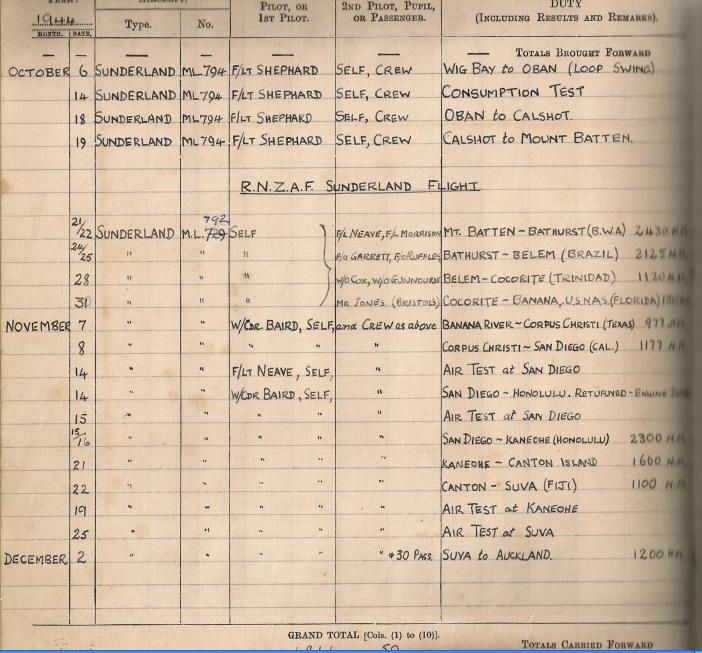 |
|



